

































































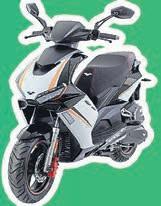







































RETRO
The inside line on going fast at Brands, Donington and Oulton Bag a bargain in Suzuki’s RF900 Suzuki scoots, A.J.S. scramblers and advice on buying your first bike kit To the Cairngorms and back on three of the most important sport tourers on the market BIG MILES NEW TO RIDING? WE’VE GOT YOU COVERED Bringing YOU the BEST of biking for FREE
LEARNER LEGAL TRACKDAY TIPS
ROCKET




















from the Editor


I’ve done a lot of riding this past month. I’ve been exploring green lanes on a pair of A.J.S. scramblers; getting acquainted with my KTM Duke 790 long-termer; test riding a trio of Ducatis on the roads around Silverstone; and heading out for a blast on Energica’s so-called electric adventure bike. And I also had a few days in the Peak District for the next instalment of Motorcycle Sport and Leisure magazine’s National Park guides. We were riding an eclectic bunch of bikes: putting Honda’s Goldwing,

rmowbray@mortons.co.uk

Suzuki’s Hayabusa, Yamaha’s MT-09 and Moto Morini's X-Cape 650 to the test in an attempt to show that you really can ‘adventure’ on anything.
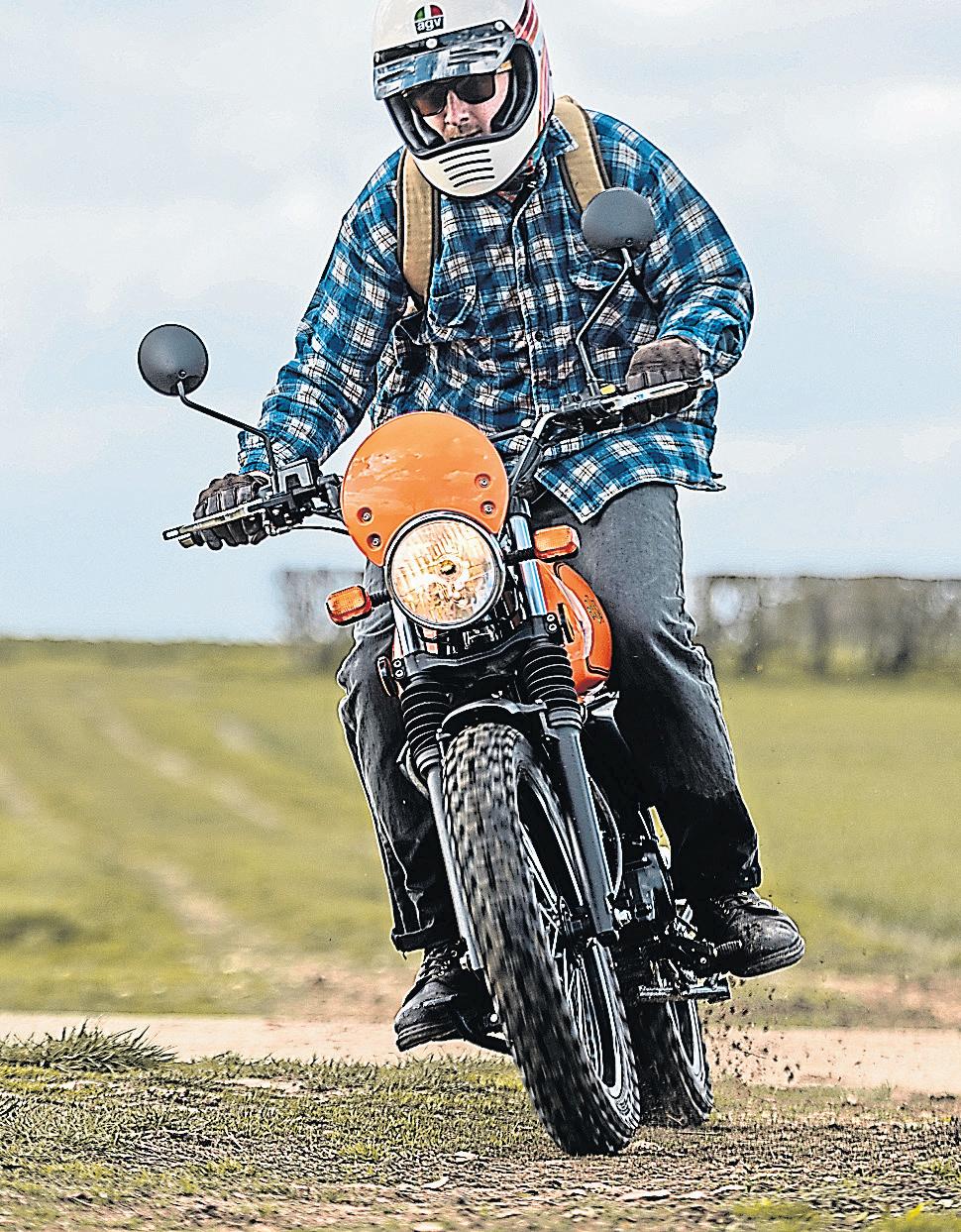


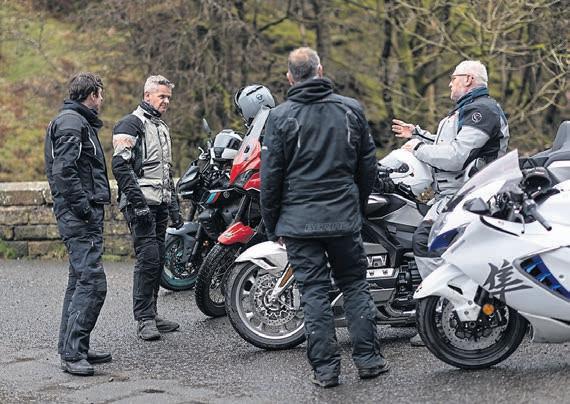
It’s always great to ride in the Peak District. Although we were treated to some pretty shocking weather, there was plenty of fun to be had hitting up some of the most iconic roads in the UK (even if we were stifled slightly by the widespread 50mph speed limits). But it was actually away from the betterknown roads that we really had some fun. Now I know the Peaks pretty well,

as I’ve spent plenty of time there over the years, both on and off the bike, and yet I was surprised to still find some undiscovered gems away from the tourist trail. It just goes to show how much great riding there is right across the UK that I’ve yet to experience. What about you? Do you have a favourite ride that's off-the-beaten-track? We'd love to hear about it.
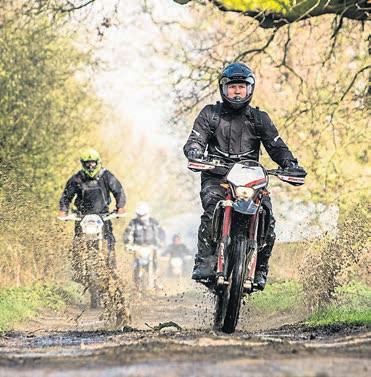

nod
Editor MB recommends bikesafe.co.uk MoreBikes, Media Centre, Morton Way, Horncastle, Lincolnshire LN9 6JR Tel: 01507 529529 Editor Ross Mowbray Editorial design Fran Lovely Publishing Director Dan Savage Email editorial@morebikes.co.uk Production Editor Mike Cowton Group Advertising Manager Sue Keily Advertising Simon Meyer 01507 529310 Advertising deadline for July issue June 1, 2023 Sales and Distribution Manager Carl Smith Marketing Manager Charlotte Park Commercial Director Nigel Hole Customer services number 01507 529529 Telephone lines are open Monday-Friday 8.30am-5pm Call 01507 529529 or visit classicmagazines.co.uk/MB10 or email subscriptions@mortons.co.uk MoreBikes is published monthly by Mortons Media Group Ltd and printed by Mortons Print. Subscribe to MB and just pay the postage! INSIDE THIS MONTH
BEST ROAD
THE UK? The Cairngorms Snow Road is something special HIT
TRAILS Top tips for taking your bike off-the-beaten-track We ride two funky scramblers from A.J.S. on- and off-road
A quick blast on Triumph’s smallest adventure tourer 40 47 31 28 24 JUNE 2023 THE SIMPLE LIFE SUPERBIKE SET UP The inside line on how to get your ride ready to race MoreBikesEvenMoreBikesOfficialMoreBikes NEWS 3
A
THE
IN
THE
EASY TIGER
Are Harley-Davidson’s Street Glide and Road Glide better than ever? LIMITED EDITION
The American factory has broken cover with limited edition versions of its fully-loaded Street Glide and Road Glide. And the big news is that they’ll be powered by a swanky new V-twin engine which has Variable Valve Timing.
It’s going to be a big year for HarleyDavidson. The iconic American firm is celebrating 120 years of production in 2023 – and to celebrate, it’s created a load of funky special versions of some of its best-known models.
Speaking about the bikes, H-D CEO, Chairman and President Jochen Zeitz said: “With the introduction of the all-new CVO Street Glide and CVO Road Glide, we’ve completely reimagined two of Harley-Davidson’s most iconic motorcycles and redefined the boundaries of CVO in the process.
“By rethinking these two models from the ground up, we are ushering in a new era of innovation, design, engineering and technology, while expanding the definition of HarleyDavidson CVO and taking the Grand American Touring experience to
another level. The new CVO Street Glide and CVO Road Glide break the mould and reset the bar for the pinnacle Harley-Davidson riding experience.”

It’s not released all the details just yet, and we’ll have to wait until June for its big bashes in both Milwaukee and Budapest for the full lowdown, but we have managed to find out a few key things about the whopping Harleys, including that both bikes will get a new Milwaukee-Eight VVT 121 engine, all-new suspension, and a top-spec infotainment system. Not bad, right? And gleaning more information from the teaser video and snaps, it’s fair to assume the new bikes will come kitted out with upsidedown forks, radially-mounted Brembo front calipers, plenty of LED lighting, and a large TFT display.
Although we might not have all the details, it is fair to assume that the new Street Glide and Road Glide will be pretty special bits of kit. That’s because they’re being looked after by
TOP TECH! Latest generation of Garmin’s rugged sat-nav

Garmin has unveiled its zumo XT2 – and reckons it’s the company’s most advanced purpose-built motorcycle sat-nav yet. Here are the specs.
Garmin’s zumo XT has built up a solid reputation since its release a few years ago, and the sat-nav specialist looks to be taking thing even further with the zumo XT2.
It features a bigger and brighter screen than the previous model; has been purpose-built for motorbike rides; and is designed to withstand all kinds of weather and rough terrain. It’s also undergone tough vibration testing to ensure that it’s capable of keeping you on track on the roughest of journeys.
There’s also a new Group Ride Mobile feature, which allows a rider to track their friend’s location when both are using the Tread app – or it can be used with the Group Ride Tracker aftermarket accessory. It’s a clever bit of kit which allows you to track friends when no cellular coverage is available. If that’s not enough, it can also be used with an inReach satellite communicator, and if you’ve got a subscription you can send messages, share locations and transmit an SOS. Proper stuff for proper adventurers.
There’s plenty of other good stuff to get excited about, including a new visual route planner; routes and recommendations from MICHELIN Scenic Roads and the MICHELIN Green Guide; and an improved Garmin Adventurous Routing to find hills, curves and the best sights.

Available now, you can get your hands on the zumo XT2 for the princely sum of £529.99. Not cheap, but by the sound of all the technology it’s got packed inside, it’s well worth the cast. More at: www.garmin.com
H-D’s CVO department, which has built up an enviable reputation for building trick bikes for over 20 years. As you’d expect, they usually have a price tag to match – and so it’d be fair
to assume these two will cost in excess of £30,000 (particularly when you consider the £50,395 CVO Road Glide Limited released back in January to celebrate the firm’s 120th birthday).
4 NEWS
RACE READY
Team Classic Suzuki has revealed its latest retro race bike build – and this time it’s a trick first generation GSX-R1000.

We love to see what Team Classic Suzuki has been up to. It knows what it’s doing when it comes to setting up retro bikes for the racetrack.
Over the years, it’s created some seriously special race-ready machines, including a trick Katana back in 2017. The Katana enjoyed plenty of race success, but a recent rule change has opened things up – and now the GSX-R1000 K1 is eligible for the European Endurance


Cup rounds. It definitely looks the part, with the Team Classic Suzuki livery complemented by a rebuilt GSX-R1000 engine, a set of Yoshimura cams and a full titanium Yoshimura exhaust system. It makes use of the standard frame, but gets the swingarm from a factory GSX-R750 endurance racer, some OZ wheels, a K-Tech rear shock, K-Tech internals for the Team Classic Suzuki front forks, and some Brembo bikes.
Speaking about the bike, Team Classic Suzuki’s Nathan Colombi said: “Once the rules opened up to allow GSX-Rs in, we had to get involved and build our own. To be honest it came together quite quickly and we’re still finalising our plans for the season, but it’s great – if a bit terrifying that so much time has passed – that GSX-R1000s can go classic racing now.
“We’ve obviously used a lot of performance parts in the build, but we’ve











been able to use Suzuki’s Race Parts Programme when we’ve needed genuine components, which will be of use for anyone else racing a GSX-R in this series, club racing, or at national level.”



The guys at Team Classic Suzuki kicked off the race season at Paul Ricard at the start of May, but it’s yet to confirm its plans for the season so we’ll have to sit tight to find out when we can next see it in action.

NEWS 5
Husqvarna’s Motocross range gets revealed

The latest batch of race-ready off-roaders from Husky has arrived. And there’re some trick new graphics and suspension settings to get excited about.
It’s that time of the year when next year’s motocross bikes get their big reveal, and following on from KTM’s big announcement, its sister brand Husqvarna has revealed its own whopping range of bikes.
As you’d expect, things are much the same for the new Huskys as they are for the new KTM’s – so that means we’re not exactly shocked by what’s been changed for the latest batch of Husqvarna off-roaders.
In total there are five models to choose from, with two two-strokes – the TC 125 and TC 250 - and three fourstrokes – the FC 250, FC 350 and FC 450. Though things are largely unchanged from last year, there’s still plenty to get excited about, most notably some uprated suspension set up to help improve cornering agility. More specifically, the WP XACT 48mm front forks and
WP XACT rear shock get some new settings, now coming with plenty of customisation and fine-tuning capability thanks to the easy access, tool-free adjusters.
The other big news is the funky new grey and yellow graphics, which are a bit of a departure from the more traditional blue, white and yellow scheme.












































The new batch of motocross machines still come kitted out with ProTaper handlebars, a high-performance Brembo hydraulic clutch, Dunlop tyres and a multifunctional map select switch which activates the built-in Quickshifter, Traction and Launch Control. We’re still waiting for the lowdown on prices, but considering that they’re expected to roll into dealers this month, we shouldn’t have to wait too long to get the lowdown.
Is Yamaha planning on bringing back the RD?

Yamaha’s filed some documents which suggest we might be getting a modern retro reboot of its iconic RD250 and RD350. Here’s what we know so far.
Yamaha’s RD250 and RD350 remain some of the best-loved motorcycles among those of a certain vintage. And for good reason. The two-stroke pocket rockets gave a whole generation of riders their first proper taste of speed, before the UK Government changed the rules for learners in 1983 (restricting them to 125cc machines).
And now it looks like Yamaha’s preparing to make the most of that rich legacy, because we’ve just got wind that the Japanese factory has trademarked the RZ250 and RZ350 name on its home turf. Yes, you read that right – the RD was known as the RZ back in Japan (and a few other places, too).
That’s why it’s not too difficult to make the very small leap and assume that Yamaha’s looking to introduce a modern take on two of its best-loved models.
But will we see them in the UK, and if we do, will they be able to live up to the RD/RZ name? In truth, it’s tricky to know for sure. There’s a good chance Yamaha could just be filing the trademark to ensure it keeps hold of the rights to the name, but even if that’s not what’s going on, then it’s still fairly unlikely we’re going to see any fiery two-strokers soon (though there’s no harm in holding out hope).





















































It’s much more probable that the factory’s wanting to make use of the famous name for a new machine which looks the part but features a conventional four-stroke motor. It’s increasingly common in the modern motorcycle world – and although there’s often disappointment from those who knew and loved the originals, it’s the only practical choice with ever-tightening emissions regulations. Yamaha’s recentlyreleased R7 is the perfect example – not a patch on the iconic in-line four 750cc sports bike built for the track, but still a cracking bike in its own right.

6 NEWS
After much teasing, the latest version of the Austrian factory’s SMT is finally here. It’s a funky proposition, offering a neat mix of supermoto performance and big-mile touring capability. Sitting in the range between the 890 Duke and 890 Adventure, the longlegged 194kg corner carver was first spotted testing way back in October 2021 – but it’s taken until now for the factory to release it out into the wild.
It’s powered by KTM’s heralded 889cc LC8c paralleltwin engine (as found in the Duke and Adventure), but it’s had a bit of a retune to better suit the SMT. Getting into specifics, the motor kicks out a healthy 103.6bhp at 8000rpm and 73.8lb-ft of torque at 6500rpm.








It also gets the same steel main frame as the 890 Adventure, though there’s slightly revised geometry to





















improve cornering prowess, while the shock absorber has been reduced to bring the seat height down to 860mm and a new longer swingarm will help aid straight-line stability.

Suspension comes in the form of a set of rebound and preload adjustable 43mm WP Apex upside-down forks with 180mm of travel up front, and at the rear there’s a reboundadjustable shock with 180mm of travel. Stopping is looked after by a pair of four-piston calipers and 320mm front discs up front, and the 17-inch rims are shod in a set of sticky Michelin PowerGP tyres. And as you’d expect, there's a full suite of electronics too.









Priced at £12,499 and available in May, we’ve got a very good feeling about the sporty tourer from KTM and we can’t wait to put it to the test. If you want to know more, then head to your closest dealer.

NEWS 7
KTM’s touring-ready supermoto is back with a bang. Here’s what you need to know.
✪ PRODUCTS ✪ PRODUCTS ✪ PRODUCTS ✪
Arn Race Leathers

£350 / www.raceleather.co.uk
These ARN made-to-measure leathers are made from 1.4mm-1.5mm soft grain cowhide or 0.8mm kangaroo hide. Triple stitched, they can come with or without a race hump. They have a 100% polymesh liner and a neoprene collar for comfort. Pockets are used for the removable CE approved elbow, shoulder, knee, thigh and back protection. You’ve also got stretch/Kevlar panels for fit. Rough prices suggest a kids’ suit comes in at £350, teens £550 and adults £750.
Dunlop Sportmax Q-Lite Tyres
£150 / www.dunlop.eu
The main strength of small sportsbikes is their light weight and potential high corner speed, meaning it makes zero sense to skimp on rubber for ‘em. So it’s great to see these new Dunlop Sportmax Q-Lite tyres, designed for the likes of the Yamaha YZF-R3, KTM Duke 390 and Kawasaki Ninja 250. Available in a wide range of small bike sizes, they are claimed to offer hypersports performance, while still giving great mileage and improved handling. And despite the sporty tread pattern, the firm reckons they have great wet performance, too. RRP: from £150/pair www.dunlop.eu

Roadskin Taranis Elite Jeans

£179.99 / www.roadskin.co.uk

Roadskin’s Taranis Elite motorcycle jeans provide a AAA safety rating in a single layer, as tested by SATRA Technology Centre in the UK. This is achieved by weaving the protective Kevlar fibres into premium denim, so they feel and look exactly like a regular five-pocket pair of jeans but give the peace of mind that comes with wearing AAAs (jeans, not batteries.) The Taranis also contains a good amount of elastane for stretch, ensuring riders will be as comfortable on the bike as off it.
The Roadskin Taranis jeans are also lined with a special mesh that not only helps keep motorcyclists cool in the summer months, but also more importantly protects skin from tearing during the initial impact when involved in an accident. Available with a straight leg in a dark indigo or black denim in sizes 28-46 waist and short, regular or long length.
Spada Lambert Jacket
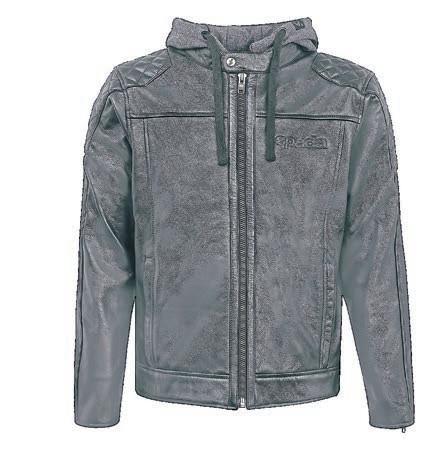
£299.99 / www.spadaclothing.com
The new Lambert jacket has an understated café racer style (it says ‘ere) and authentic ride-and-wear silhouette – whatever that is? Crafted from premium leather, the jacket features diamond shoulder detailing, quality silver zippers and stud fasteners, twill satin lining, and a detachable soft fleece hood. Level 2 CE five-piece armour is in the shoulders, elbows and back.
Island
Racer 2023
£9.99 / www.mortonsbooks.co.uk
148 pages packed with Isle of Man TT action. The magazine looks at this year’s runners and riders, and also takes a look back at the best of road-racing.

Oxford Hot Grips
£199 / www.oxfordproducts.com

Clarke Boltless Shelving

£50-£350 / www.machinemart.co.uk
Clarke has released a new range of boltless shelving. The shelves combine tough steel construction with quick and easy boltless assembly – only a hammer is required. High-quality 8mm chipboard shelves are used and feature adjustable heights. The wide, spacious design allows for ample storage space, while a durable powder-coated finish protects the shelves from damage.
Okay, summer’s on the way, but heated grips are useful all year round – it can still get chilly in the morning and nothing beats warm pinkies, even if you’re wearing summer gloves. These are Oxford’s latest design, the Hot Grips Pro, and they’ve got the latest generation of tech. There’s no separate control button; rather, you have a control on the grip itself, with an LED indicator of heat level on the left grip. They store the previous setting in memory, and also have an auto cut-off function so will never flatten your battery. Available in three grip pattern designs for adventure, touring or sports bikes.
8 PRODUCTS




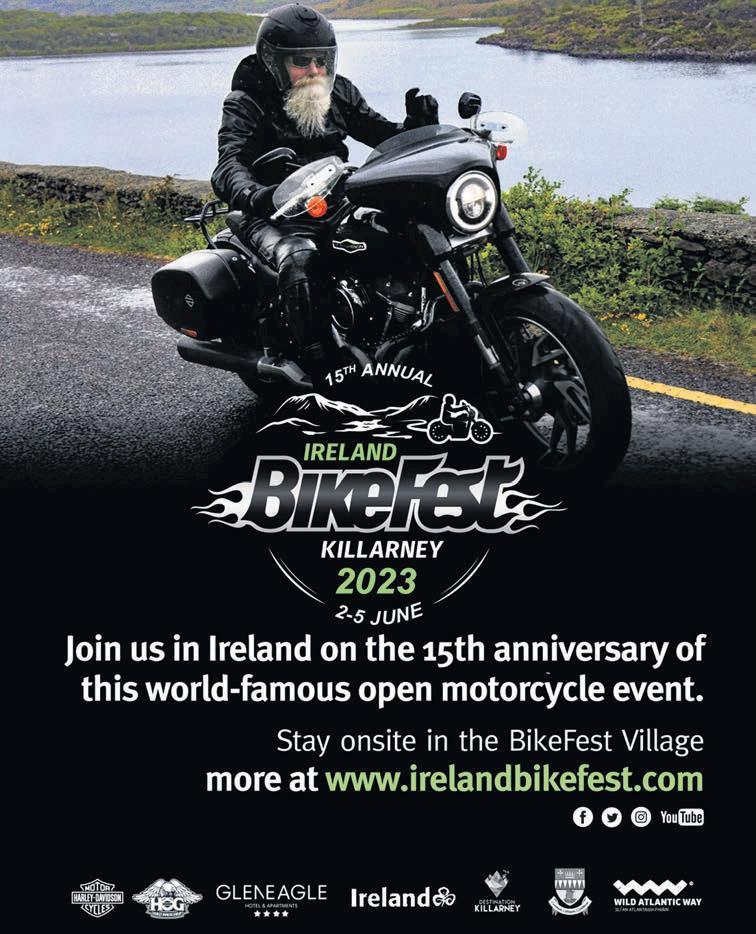







































Q&A
Our specialist motoring solicitor Andrew Prendergast guides readers through their legal trials and troubles
QI am an all-year-round biker for the simple fact I don’t have a car licence and I love riding bikes. I got ‘bitten by the biking bug’ back in the nineties and I’ve ridden all round the world, twice (amongst a whole bunch of other trips). I love it. After my last trip (which got disrupted quite a bit due to the poxy pandemic) I took on a job at a bread factory to save up some ‘dough’ (like what I did there!). It’s not the most glamorous job in the world, but the pay is pretty good and there is plenty of opportunity for overtime… plus cheap bakery products! Who doesn’t like a big cob to nibble on? Anyways, I was riding to work through the industrial estate one morning and there had been a sharp frost overnight (that was forecast). Unfortunately, a recovery truck company had washed their wagons the previous evening and the water they used had frozen on the road overnight. You can guess the rest. I hit the ice, lost control and went down quicker than a fat lad on a seesaw. The net result of that is I have broken an arm and a leg. My view is, is it the recovery truck company’s fault? My insurance company reckons it’s the local council’s fault as they should have gritted the road. I followed their lead (I’m just a humble bread maker, what do I know?!) but I’ve just got a letter from them saying the council rejected the claim they put forward for the money my
insurer paid me for my damaged bike. My insurer also said they can’t help anymore. I was none too happy when I spoke to them as they then told me they hadn’t told the council about my injuries. WTAF! Thankfully my governor took some photos of me and the bike laid on the skating ring. You can see the water had run down their offending yard, on to the road and frozen. Apparently the recovery truck company have done this before. Please help.
AThe phrase not knowing their arse from their elbow springs to mind…. First things first, you’re right and your insurer is wrong. If the recovery truck company left water all over the road and it freezes on a (forecasted) cold night, then your claim should be directed at them, not the local council. The council didn’t put the hazard there. Next, evidence. You are going to need a statement from your governor and his photos to prove negligence on the part of the recovery truck company. Lastly, it looks like your insurer was only trying to help itself by getting the money it paid out to you for your bike back. My advice is sack off speaking to your (idiot) insurer, get a solicitor and crack on with a claim against the recovery truck company. Your insurer will not help you get compensation.
QI’m a police officer and have been in the job for nearly 10 years. I’ve got a mate who’s been in six months longer than me and he has just been revetted. It’s a hot topic at the moment and I’m expecting to get hit up on my 10-year anniversary. Now here’s the problem. Over Easter I went over to Spain and rented a KTM 890 Adventure with a mate. I must confess I had the mindset that the Spanish Police and authorities can’t really do much to us Brits post Brexit, so we ragged it everywhere. We were on a ‘spirited ride’ through a mountain town when I saw a speed camera flash. Later that night my mate (another police officer) laughed and said it wasn’t illegal if you were abroad! The problem I now have is the Spanish authorities have written, directing me to pay a fine. I was doing 87kmph in a 50kmph zone. They must have got my address from the rental company. I’ve read online that Spain can’t endorse points on my UK licence so I’m minded to ignore it. However, I’m worried about my revetting. What do you think? I would also add that I am in a road policing unit.
AAs you will be aware, police vetting is essential in assessing an individual’s integrity and so has a strong link to public trust and confidence in policing. Therefore, what will ignoring the Spanish Police/authorities say
The firm deals with personal injury claims and its sister company, Motor Defence Solicitors, deals with all the motoring offences. White Dalton lawyers have a vast knowledge of bike law, and they have full bike licences, too. They don’t act for insurance companies or the prosecution.
White Dalton is Britain’s premier specialist motorcycle law practice, and if its professionals don’t know the answer

about you? Leaving that question to hang for a moment, I think you’re a class-A ball bag. You’re a policeman in a road policing unit. 50kmph zones are for built-up areas and you’re ragging through it like a private racetrack. What would you as a British policeman say to the Spanish driver if you caught them ragging through a British village at 54mph in a 30mph zone? I suspect you would through the book at them. Leaving aside the fact you have been an utter dipstick, it is correct that a foreign country cannot endorse penalty points on your UK licence. However, there is nothing stopping them pursing you for the fine either in the UK or Spanish courts. I also have concerns that if you do not pay the fine and try to ignore it, you could be prosecuted in a criminal court in Spain (either with or without your attendance) and you will have turned a simple speeding fine into a much bigger problem as you will then have to declare a criminal court conviction. My advice is that you want to avoid court proceedings either in the UK or in Spain as I suspect that may well affect your revetting. Practically, my advice is pay the fine. Then you will have to check with your police force if you have to disclose a Spanish speeding fine during any revetting. Even if you do, I suspect it will unlikely make a difference.
to your question, there probably isn’t one. Don’t rely on the advice from your insurance-appointed solicitor, get proper independent advice.
For road traffic offences, call the Motor Defence solicitors on 0800 280 0912. For non-offence cases, call White Dalton motorcycle solicitors on 0800 783 6191.


If you need advice on a biking-related legal question or query, email mail@whitedalton. co.uk. The best Q&A will be published in MB, in confidence, of course.

S O L I C T O R S www.whitedalton.co.uk
The MB legal column is compiled by managing partner Andrew ‘Chef’ Prendergast and his bike-riding barristers and solicitors at White Dalton Motorcycle Solicitors.
10 WHITE DALTON
We love to see what you lot are riding – and we know the rest of you like it, too. It’s just like pottering around a bike night and checking out what’s been brought out for a ride. Now we’ve decided to bring the bike night to you, asking readers to send us photos of their pride and joy for the world to see. Here’re some of our top picks from the last month.

BIKER-FRIENDLY GUIDE

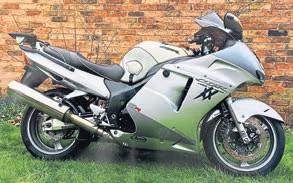


FATBOY’S DINER
The image is synonymous with biking. Pull up on your bike, grab a drink and a bite at a classic Airstream roadside diner. What would you say if I said you don’t need to head to the USA… but Silvertown, East London? That is the home of Fatboy’s Diner. Now located in Trinity Buoy Wharf, Fatboy’s has led a nomadic life.

Built in the mid-1950s, originally known as Randy’s Roast Beef in Georgetown, Massachusetts; the last of its kind built by the Worcester Lunch Car Company. Some point during the next 20 years it relocated to the Metro-Boston area, becoming a facade for a pizzeria. 1982, the diner

was sold, but sat decaying until in 1989 it was bought and sold in quick succession to Trevor Gulliver who was opening a new Fatboy’s Diner chain in London.







The chain only lasted a couple of years... the last one remaining?
The former Randy’s Roast Beef. Located across from Liverpool Street Station (where I first discovered it), eventually heading to Trinity Buoy Wharf, a former buoy-making facility reinvented as an arts community.


Fatboy’s is famed as a filming location. Perhaps it’s most famous scene is from the 1998 Gwyneth Paltrow film ‘Sliding Doors’. It has featured in a number of other films, TV series and music videos with the likes of Amy Winehouse, Rose Elinor Dougall and Bastille filming there.
‘The Great British Sewing Bee’ 2021 season was filmed in Trinity Buoy Wharf, with the contestants retiring to Fatboy’s.
2022 and new ownership. Chef Les Nkansah trained under John Torode at Mezzo, Soho, before working with the likes of Gordon Ramsay and Angela Hartnett, then travelling the world. Upon his return to the UK in 2017, he started with a food stall in Camden Market before opening popups, then a series of pub residencies with the Star group.
Les truly loves cooking with fresh, seasonal ingredients, even recently going to the lengths of acquiring an allotment plot to grow organic
seasonal veg! Fatboy's makes all its own burgers, sauces and marinades to set them apart.

With new ownership comes a new twist to the traditional Fatboy’s menu. Alongside the Full English breakfasts (they looked amazing), burgers and hot dogs, Caribbean dishes have been added which had to be tried (there are times I love this job). I had the Buttermilk Jerk Burger (£9.75), and my wife Laura had the Chicken, Waffle and Bacon (£16.50).
The burger: Chicken thighs covered in jerk sauce, nestled on crunchy slaw in a brioche bun. The pimentofloured buttermilk coating combined with the slaw to give a delicious crunch, contrasting the tender chicken thighs. The jerk sauce, spicy with a gentle heat. The sweet, soft waffle was balanced by the crispiness of the bacon, the chicken again tender against the crunchy jerk coating. The
maple syrup complemented the jerk sauce, the pair combining to give just the right amount of kick without being overpowering.
The roads surrounding Fatboy’s aren’t the most exciting, but Trinity Buoy Wharf is just minutes from the Blackwall Tunnel, the O2, City of London and perhaps most importantly the ExCel Exhibition Centre. If you’re going to a show there, ride (bikes park free). When you’re done, ride a mile-and-a-half to Fatboy’s for freshly-cooked food.
GETTING THERE
To reach Fatboy’s, follow signs to Leamouth on the A13 or from Aspen Way. At the Leamouth roundabout, take the Lower Lea Crossing exit. Almost immediately go left after the bridge, turn right and follow the road to Trinity Buoy Wharf. Parking is limited during the week.
In partnership with Forcefield Body Armour
WORDS and PHOTOS: Bob Pickett
Adam Doggett’s Harley-Davidson looks ready for action.
Mark Wheeldon’s immaculate Yamaha SR400. “I bought it a few weeks ago. It’s quite recent, 2014. It’s in amazing condition and only 1500 miles.”
Russell Hale’s Triton – minus Manx tanks and clip-ons, giving a more comfortable ride!
Chris Forster’s made of sterner stuff. Here’s his fully-loaded Yamaha Tracer in Snowdonia back in February.
Right: Pete Martin’s Yamaha Fazer. We love this bike. It’s a real do anything machine.
Dave Clark’s Honda Blackbird. He’s had it from new since 2005 and it’s still going strong! It’s got some bar risers and full Maxton upgrade front and rear – the perfect keeper!
Andrew Dixon’s Suzuki GT750 gleaming in the sunshine. We’d love one of these in the shed.
Patrik Ornst’s Yamaha XJ600 from 1991. Proper job.
David Southgate’s 2018 BMW R1200GS TE Rallye. Now that’s a serious bit of kit. You could go anywhere on this thing.
Left: Dex Stewart’s Kawasaki ZZR 1100. He bought it new in 1995 and still has it! “Wouldn’t part with it, it handles a dream on the twisties, and eats the miles.”
Ralph Itzin’s Honda CBX 1000 CB1 from 1979 is one hell of a looker.
FATBOY’S DINER Trinity Buoy Wharf 64 Orchard Place Poplar, London E14 0JW www.facebook.com/ fatboysdiner
YOUR RIDE/BIKER GUIDE 11
It’s time to get out your pens and pencils and put your grey matter to the test
memories to the limit and asking you to dig deep to try and remember all manner of strange stuff from right across the biking spectrum. It’s a chance for you to show off your infinite wisdom and be in with a shot of bagging some cool prizes.
All you’ve got to do is jot the answers down on the entry form below, and send it in using the details provided. We’ll then pick the winner from an upturned helmet crammed with correct answers, and that person will be sent a brand-new bit of kit that’ll help them stay safe out on the road. It’s that simple. Get cracking for the chance to win. Good luck!
How much power does Kawasaki’s
What’s the name of the stunning stretch of road that cuts through the heart of
In which year did Kenny Roberts go full
Which new KTM model shares a motor with the 890 Duke and 890 Adventure?
When was the iconic British firm AJS
LAST MONTH:
How about this for a cool bit of riding kit? This lumberjackstyle shirt from Weise might look like it’d be more at home in a Shoreditch boozer than at a bike meet, but actually, it’s a properly equipped bit of kit that’ll help to look after you on the road. A-rated for protection, it’s equipped with an abrasion-resistant aramid lining and gets CE-approved armour at the elbow, shoulder and back. Want to know more?

£139.Worth99
7
8 9
6 10
Which is the only piece of motorcycle kit the law requires you to wear?


Which French firm was founded in 1986 by racers Andre and Robert Teston?

On which bike did Kenny Roberts make his name on the dirt ovals of America?
Which machine has Triumph tweaked to create its Tiger Sport 660?
Suzuki RG500, 130000, Hornet, 999, Snowboarding, 1976, 2 years, Vanishing Point, 29, TTMA
12 COMPETITION Here’s the legal bit that you need to know Fill in your details on the form or enter online and return to: MoreBikes, Weise Redwood shirt, 2023 Competition, Mortons Media Group Ltd, Morton Way, Horncastle, Lincs LN9 6JR. Competition closes: June 9, 2023 1.......................................................................... 2. .................................................................................. 3. ............................................................................. 4. ........................................................................ 5. .................................................................................. 6. ............................................................................. 7. ........................................................................ 8. .................................................................................. 9. ............................................................................. 10. ...................................................................... Mr / Mrs / Miss / Ms (please circle) First name:...................................................................................... Surname:............................................................................................................................... Address:....................................................................................................................................................................................................................................... Town/City:........................................................................ County:.......................................................... Postcode:.................................................................... Email:............................................................................................................. Telephone:............................................................................................................ There are no cash alternatives available. The winner(s) of the Weise Redwood shirt will be the first name(s) drawn at random from the upturned MB helmet. YOU can also ENTER online! Just check out the MoreBikes social media channels for more information. Terms and conditions apply. To view the privacy policy of MMG Ltd (publisher of MB) please visit www.mortons.co.uk/privacy What’s the name of the Europe-wide resource that brings together
of miles of off-road
thousands
trails? THE MOREBQUIZIKES
✂
WIN!
Visit: www.weiseclothing.com








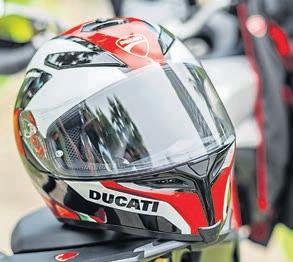




ADVERTORIAL 13 1) Company C4 Leather Jacket Price: £359 2) Downtown C2 Short Boots Price: £189 3) Valencia Sunglasses Price: £109 4) Outdoor C3 Fabric Jacket Price: £299 5) Company C4 Jeans Price: £179 6) Redline B4 Rucksack Price: £129 7) Ducati Corse C6 Leather Jacket Price: £639 8) Downtown C2 Technical Sweatshirt Price: £189 9) Logo Hooded Sweatshirt Price: £69 10) DC Sport Polo Price: £49.90 11) Peak V5 Price: £299 12) Ducati Corse V6 Helmet Price: £849 1 5 11 3 2 6 9 12 4 7 8 10 The Ducati collection is available now in your local Ducati Dealership. For details on your local dealer visit: www.ducatiuk.com

14
GROUP TEST: KAWASAKI H2 SX SE TOURER, SUZUKI GSX-S1000GT AND HONDA NT1100
HIGHLAND

Here at MoreBikes we love our sport as much as we love our leisure, and what better way to celebrate both than take three of the most exciting new sports tourers up to Scotland for a big-miles test.
With plenty of sport and a whole load of leisure, MSL magazine covers the whole spectrum of biking. In the last issue alone there was an in-depth look at Aston Martin and Brough’s super exclusive AMB 001, a launch ride on the brand new Honda Transalp and Husqvarna Norden, and a report from the frontline of the Suzuki Bandit Championship – and that’s only the tip of the iceberg.
 WORDS: Dave Manning, Gary Hartshorne, Ross Mowbray PHOTOS: Gary Chapman
WORDS: Dave Manning, Gary Hartshorne, Ross Mowbray PHOTOS: Gary Chapman
GROUP TEST: KAWASAKI H2 SX SE TOURER, SUZUKI GSX-S1000GT AND HONDA NT1100 15
POWERED BY GAMES
GROUP TEST: KAWASAKI H2 SX SE TOURER, SUZUKI GSX-S1000GT AND HONDA NT1100
Kawasaki H2 SX SE Tourer
The supercharged one that’s perfect for covering big miles fast
WORDS: Ross Mowbray

In recent years, Kawasaki’s carved out a niche for itself: building bonkers supercharged bikes that go like the clappers. But I’ve never actually ridden one before. I’ve heard very good things, with friends, colleagues and owners raving about how fast, smooth and stable they are, so I couldn’t wait to try out its touring-ready model on a big trip to the Cairngorms.
First introduced into Kawasaki’s growing supercharged range back in 2018, the H2 SX SE Tourer is a seriously well-equipped motorcycle. In addition to its 197bhp motor, it gets electronic suspension; superbike-specification Brembo brakes; heated grips; a TFT screen;
adaptive cruise control; blind spot detection; and a collision warning system. That’s not a bad start, is it? It looks good, too, with the smart lines of its aerodynamic fins and its futuristic round headlight helping it stand out from the crowd, while Kawasaki’s exceptional build quality shines through. In the flesh, it’s immediately clear that it’s a big old lump of a motorcycle. It weighs in at 267kg and has a wheelbase of 1480mm, but with a relatively low seat height of 835mm and a well-balanced centre of gravity, it’s easy enough to paddle around and back out of spaces. It’s much more comfortable than I expected, too, with its clip-on bars rising back from the top yoke, meaning you’re not laying down on the tank with all the weight on your wrists (which would no doubt take its toll on longer journeys).
Bonkers power
The most exciting bit about the H2 SX SE Tourer is its engine. Kicking out a mighty 197.3bhp at 11,000rpm and 101.3lb-ft at 8500rpm, it’ll come as no surprise that the big ‘Kwaker’ can hustle. But most of the time you’ll not get close to making the most out of the engine, so it’s just as important to appraise how well it potters and cruises as it is to wax lyrical about how much fun it is when you wind open the throttle. In truth, it’s surprisingly docile when you want it to be, with its smooth throttle and easy-going power delivery meaning you can happily cut through towns and villages without upsetting the locals, and sit at a steady 60mph without feeling encouraged to press on. But when you do wind open the throttle, the way it delivers power is so subtle that you’ll find yourself creeping the wrong side of the speed limit all too easily.
It’s at its best and most addictive between 6000 and 8000 revs – and if you’re anything like me, you’ll need to keep a close eye on the speedo, because you’ll be in triple digits within the blink of an eye.
It might not look like much when you consider the sophistication of some of the other screens on other bikes, but the Kawasaki has plenty going for it. You can flick between rider modes, dial in the adaptive cruise control and much, much more



16
The hulking great exhaust isn’t exactly a looker, but it’s been designed to keep emissions down and ensure the big ‘Kwaker’ meets Euro 5 regulations
TECH SPEC
Kawasaki H2 SX SE Tourer


Price: £25,229
Engine: 998cc liquid-cooled, 4-stroke, inline four, DOHC
Power: 197.3bhp @ 11,000rpm
Torque: 101.3lb-ft @ 8,500rpm

Frame: Trellis, high-tensile steel, with swingarm mounting plate
Wheelbase: 1480mm
Brakes: (F) Dual radial-mount, opposed 4-piston Brembo. Stylema calipers, dual semi-floating 320mm discs and KIBS ABS (R) Opposed 2-piston calipers, single 250mm disc and KIBS ABS
Transmission: 6-speed, return, dog-ring and sealed chain final drive
Suspension: (F) 43mm inverted fork with KECS-controlled rebound and compression damping, manual spring preload adjustability and top-out springs (R) Uni-Trak with Showa BFRC Lite gas-charged shock with piggyback reservoir, KECS-controlled compression and rebound damping and electronically-adjustable spring preload
Wheels/tyres: (F) 120/70 ZR17 / (R) 190/55
ZR17
Seat height: 835mm (32.9in)
Fuel capacity: 19 litres
MPG: 52mpg (claimed), 47mpg (tested)
Weight: 267kg (wet)
Warranty: 2 years
Maintenance interval: 7500 miles
Contact: www.kawasaki.com
PROS & CONS
+ A 197bhp supercharged motor on a touring bike. What more do I need to say?
+ The comprehensive electronics suite. This is a thoroughly modern motorcycle up there with the best in the game.
– The price. It’s £25,000 – you could buy two Hondas or Suzukis for less...
And controlling that power...
Thankfully, the Brembo Stylema front brake, with its Brembo radial master cylinder which comes fitted to the SE model, does an excellent job of hauling up the hulking machine in a hurry. It’s a very good set up which works nicely with the electronic suspension to mean that there’s very little in the way of diving under even the most aggressive of braking. It’ll scrub speed well, too, and a gentle hand will have no trouble massaging the lever and pedal to help balance the big bike in the turns.
Electric suspension is becoming increasingly common among the biggest names in biking, and although Kawasaki’s might not be as silky smooth as BMW’s or Ducati’s, it’s a seriously sophisticated bit of kit which does an excellent job of keeping everything in check. While it’s definitely more tourer than sportbike, there is a selection of modes to choose from, which all alter the amount of rebound damping on offer to help you set the bike up for the type of riding
you’re going to be doing. Speaking of which, it takes a bit of time to get familiar with the numerous menus and sub menus which are accessible using the switchgear, but put the time in and you’ll be nipping between modes in no time at all.
There’s also electronic pre-load adjustment, which is a great addition on any big tourer – as when you load up with luggage (or bring a pillion along for the ride), you can tap a couple of buttons and be good to go.

There’re some nice touring goodies as standard on the top-of-the-line
H2 SX SE, including some excellent heated grips, a centre-stand for easy maintenance, and a deceptively roomy one-key pannier system, which includes two sleek 28-litre hard cases (with some internal bags). And, of course, there’s a selection of electronic goodies, including front collision warning, blind spot detection and adaptive cruise control.
I’m not usually a big fan of this sort of technology, and I’m not entirely sure about the first two, but Kawasaki’s
adaptive cruise control is fantastic (particularly when you’ve got some boring motorway miles to nail). Turn it on, set the speed and the bike will sit at the required distance from the car, van, lorry or bike in front.
Fast and furious
Kawasaki’s H2 SX SE Tourer is an excellent motorcycle. It’s smooth, stable, and, oh, so fast, but it’s not as fuel efficient, and it’s not as comfortable as a typical tourer. Nor is the big behemoth as agile or as aggressive as a typical sportbike. Maybe that’s its appeal? It kind of bridges the two worlds in a way that no other manufacturer has bothered (or dared) to do.
The H2 SX SE more than lived up to my pre-ride expectations. The engine really is remarkable, there’s some quality kit as standard, and the level of technology is impressive, but I couldn’t really get over the fact that at £25,000 (and a bit), it costs such a huge amount more than the competition.
 The supercharged inline four motor is special. It’s like nothing else on the market and is the best bit about the bike
The supercharged inline four motor is special. It’s like nothing else on the market and is the best bit about the bike
TEST: KAWASAKI H2 SX SE TOURER, SUZUKI GSX-S1000GT AND HONDA NT1100E 17
GROUP
Honda NT1100
The comfortable choice for sensible big-mile bikers


WORDS: Gary Hartshorne

As we all see huge increases in gas, oil and general living costs, saving money where we can is as important as it ever was. And as we all tighten our belts, motorcycle manufacturers are following suit. Rather than designing new bikes from the ground up, there’s a trend for current models to go through some kind of metamorphosis and be reborn as something new… and this is exactly what Honda has done with the NT1100. Based on its ever-popular Africa Twin (which I’ve done a number of miles on), I was intrigued to find out how different the road-going NT is to its adventureready sibling.
So, what’s it made of?
First off, the suspenders have been changed for a more touring-oriented posture, which lowers the seat height by 30mm to a much more managable 820mm. Wheels are now 17-inch all round as opposed to the 21-inch front
and 18-inch rear which don the CRF1100 Africa Twin. The 17s transform the bike – and are particularly noticeable when it comes to muscling the bike around the tight and twisty Cairngorms roads.
Kit-wise, the NT comes with all the bells and whistles: cruise control; heated grips; an adjustable screen (although this can only be adjusted whilst off the bike and takes some effort to move it up and down); a centre stand; Apple Car Play; and a set of side panniers, too. We also had an additional aftermarket top box which costs a wedge extra.
From a comfort perspective I found the NT like an armchair. No sitting on top, just in it. The ergonomics fitted me perfectly. I covered 1300 miles on the NT in less than a week with some 200-mile stints and I’ve got to say, it’s probably the most comfortable bike I’ve ridden. No numb posterior, no tingly fingers, nothing. The screen in the high position eliminated most buffeting.
18 GROUP TEST: KAWASAKI H2 SX SE TOURER, SUZUKI GSX-S1000GT AND HONDA NT1100
“The handling is typical Honda. It doesn’t excel anywhere, but it does everything well. It stops, goes, turns, is stable on all types of road, and offers plenty of feedback.”
TECH SPEC
Honda NT11000 (DCT)
Price: £13,499
Engine: 1084cc parallel twin with 270° crank and uni-cam
Power: 100bhp (75kW) @ 7500rpm
Torque: 77lb-ft (104Nm) @ 6250rpm
Transmission: MT: 6-speed manual
Transmission / DCT: 6-speed Dual Clutch
Transmission. Chain final drive
Frame: Steel semi double cradle
Suspension: (F) Showa 43mm SFF-BP USD fork with preload adjuster, 150mm stroke. (R) Monoblock aluminium swing arm with Pro-Link with SHOWA gascharged damper, preload adjuster, 150mm axle travel

Brakes: (F) Radial mounted four-piston calipers, 310mm floating discs, (R) Single piston caliper, 256mm single disc. 2-channel ABS
Wheels/tyres: Multi-spoke cast aluminium / (F) 120/70R17 M/C, (R) 180/55R17 M/C
Fuel tank: 20.4 litres (4.5 gallons)
Fuel consumption: Claimed 56.5mpg (20km/L)
Seat height: 820mm (32.3in)
Weight: MT: 238Kg/ DCT: 248Kg
Warranty: Two years/unlimited miles
Service intervals: 8000 miles
Contact: www.honda.co.uk/motorcycles
PROS & CONS
+ Easy to ride + Well equipped + DCT better than you might think – Marmite styling – Colours on offer – Fiddly screen
The dual dash was at a good height, and a quick glance down was all it took to see the information I needed and I’m 6ft 1in, so for those of a shorter nature, it would be even easier to view.
I found the cruise control buttons that are on the right-hand side a little awkward to operate as they sit right at the bottom of the cluster, while (to me) the left-hand cluster looks as though it was thrown together in no particular order. Buttons for the TFT dash were just about where I’d want the indicator stork, and the horn was where the gearshift paddle should be. The permanently-on indicators continuously shine in the transparent wind deflectors each side of the main screen, which I found very off-putting and distracting. The Apple Car Play: I just could not get it to work at all. I’m usually pretty good with modern technology but I really couldn’t figure this one out. Once its up and running, I’m sure it’ll be superb, but sadly I didn’t get the chance to see it in action.
Getting used to it all
I’m a bit of a purist and don’t really like having too many gadgets, and I actually didn’t know I would be riding a DCT version of the NT. Given the choice I’d have chosen a manual gearbox every time, but this is what I had, so this is what I’d ride. If you’re not familiar with the system there’s no doubt that it takes a bit of getting used to having no clutch lever and no gear lever. My 36 years of natural riding habits just wouldn’t allow me to stop reaching for the non-existent levers, and even by the time I returned home 1300 miles later, I was still searching. The DCT itself is very good, and far better than I was expecting. The general D mode is pretty boring and
offers nothing in terms of excitement, but is great for long motorway hauls.
On A and B roads, I found that D mode changes gear when you don’t want it and is a tad frustrating, and would catch me out from time to time. However, knock it over into the S modes and the NT fires into life and the more briskly you ride, the better the modes become (there’s a choice of three, progressively sporty modes to choose from). They offer a muchimproved response to the inputs your right hand is giving, and are far more in sync with the pace you’re setting. While I was initially unconvinced, I wouldn’t be put off buying an Africa Twin or an NT1100 with DCT (although I’d still prefer a manual gearbox).
The handling is typical Honda. It doesn’t excel anywhere, but it does everything well. It stops, goes, turns, is stable on all types of road, and

offers plenty of feedback. It sliced though the Cairngorm Snow Road twisties like a hot knife through butter. It’s not so fast that you arrive at the next corner and have to throw the anchor out the back, but it’s not slow, either. You really can cover miles very quickly, without scaring yourself to death in the process. It’s like a preprogramme has been entered into the ECU with a map of your journey, its effortless to ride.
Yes or no?
Overall, the NT ticks a lot of boxes, more than a lot of bikes I’ve ridden recently, and is a very, very good motorcycle; but is it a motorcycle you’ll turn around and look back at over your shoulder? Whether it is or isn’t, Honda will sell a bucketful of these because at £13,500, it represents fantastic value for money and will do the touring job very well indeed.

 Twin engines always sound good, right?
The dash has been lifted from the Africa Twin and features the TFT/LCD combo. The screen worked best in its high position
Twin engines always sound good, right?
The dash has been lifted from the Africa Twin and features the TFT/LCD combo. The screen worked best in its high position
The optional top box is very handy GROUP TEST: KAWASAKI H2 SX SE TOURER, SUZUKI GSX-S1000GT AND HONDA NT1100 19
The engine is tried and tested, and does the job well
Suzuki GSX-S1000GT
Committed to the sportier side of touring
WORDS: Dave Manning

Over the last few years there have been some poorly-aimed jibes about the assumed fact that Suzuki ‘hasn’t brought out a new bike in years’.


Suzuki’s range has been seen as consisting of a limited number of powerplants, used for different models with not a great deal of componentry being changed. The GSX-S1000 range is the prime example, with a number of different models being built around what amounts to the same engine (the GSX-R1000 K5 powerplant) and rolling chassis.

What the naysayers fail to realise is that not only is Suzuki expanding its range easily in economicallystrained times, but that they’re also actually bloody good bikes, too! And this, the 1000GT, can be viewed as being the top of the GSX-S tree.
Old spec, new performance?
So, as mentioned, the GT, like the other GSX-S950/1000 models, is powered by what is essentially the GSX-R Thou engine from 2005 – and
it is a stormer! A supersmooth powerplant that’ll pull high gears without any kind of stumble or grumble, but revs through to the 11,750rpm redline when asked, supplying a tasty 150bhp in the process. It’s not identical to the K5 engine, as it’s had tweaks such as cam retiming and changes to the combustion chamber in order to allow it to pass Euro 5 regulations, but I’d go as far as to say that these changes have actually improved the engine compared to its original form, with the only exception being a slight buzzing through the pegs from about 60mph.
The gearbox is up to usual Suzuki standards, with an excellent quickshifter/blipper combination that gives smooth shifts – up and down the box – regardless of rpm or load. Not that you actually needed to use the gearbox that much in reality, although the ’shifter gave good reason for chasing the revs if you were in a mood for more enthusiastic riding.
And the handling complements
the engine and transmission. Okay, it’s no sports bike (nor is it meant to be) but the twin spar aluminium frame (as used throughout the GSX-S series) is really flickable and well balanced; even at ultra-low speeds you can stay feet-up for ages. Yes, even me. The wide bars allow for not only a comfortable, roomy riding position, but mean you can flick the bike from side to side in an instant, and while they are wide the Suzuki is also great at slicing through standing traffic, while the high and wide mirrors are perhaps the best I’ve experienced!
The brakes aren’t quite as sharp as the engine performance might suggest is required, and they need a good ol’ tug on the lever and one finger isn’t quite enough – despite the spec of the Brembo calipers –although this could probably be resolved with some new pads of a sharper compound. Although, maybe I’m being overly critical as the ‘tourer’ part of the sports-tourer spec doesn’t demand the hyper-sensitive braking requirements of a sports bike. And, for those times that you do need to stop in a hurry, they’re perfectly efficient.
20 GROUP TEST: KAWASAKI H2 SX SE TOURER, SUZUKI GSX-S1000GT AND HONDA NT1100
“Those little lights were surprisingly bright, as Ross and Gary commented that they knew exactly where the Suzuki was in their mirrors (note - I wasn’t at the back all of the time…).”
TECH SPEC
Suzuki GSX-S 1000GT


Price: £11,999
Engine: 999cc, inline 4, l/c, 16 valves
Power: 150bhp (112kW) @ 11,000rpm
Torque: 78lb-ft (106Nm) @ 7000rpm

Frame: Twin spar aluminium
Wheelbase: 1460mm
Brakes: (F) Twin 4 piston Brembo radial calipers, 310mm discs, (R) single piston caliper, 240mm disc
Transmission: 6 gears and chain final drive
Suspension: (F) Fully adjustable 43mm KYB forks, (R) preload and rebound adjustable single shock
Wheels/tyres: 6-spoke cast aluminium wheels, (F) 120/70x17”, (R) 190/50x17”
Seat height: 810mm (31.9in)
Fuel capacity: 19 litres
MPG: 46mpg (claimed), 52.5mpg (tested)
Weight: 226kg (wet)
Warranty: 3 years
Roadside assistance: 1 year AA Suzuki
Roadside Assistance
Service intervals: 4000 miles
Contact: www.bikes.suzuki.co.uk

PROS & CONS
+ Fantastic engine + Quickshifter/blipper works beautifully + Fantastic engine – Fiddly side-opening panniers – Brakes are not the sharpest

Electronic, sweet!
The electronic suite on the GT is impressive, albeit without the multiaxis IMU that many top-of-the-rangers have now, meaning that lean-sensitive rider aids are absent. But there is a fivestage traction control, plus the ability to turn it off totally, and the easilyreadable 6.5-inch TFT dash is a nice addition that is far better than many competitors’ offerings.
The cruise control is a little glitchy, in that you have to hold the + or –buttons until the speed has changed, unlike that on the Busa where one prod would increase (or decrease) the speed by 1mph. Although treating this as a standalone bike rather than comparing it to a machine that wasn’t on this group test, then it’s perfectly satisfactory.
And for the intended trip high up in the Cairngorms, the lack of heated grips might’ve been more of an issue than it was, as we were rather lucky with the weather, but if you’re after a bike for all seasons it is a serious issue. Although they are available as an official accessory from Suzuki, albeit
at the ripe price of £395.
The 36-litre panniers (either an accessory, or included with the GT+ model that costs an extra £1000) are convenient, but they’re side openers (so stuff falls out when opening), and they’re not as expansive as they could be, and could certainly be loaded more easily if they came with fitted bags (like the Kawasaki). While they’re handy to have (as time goes by, I like hard panniers more and more), they are a little on the small side, as I could barely fit my camera bag in, and it is a really small camera bag. But they’re much better than not having any!
The styling is sharp, especially with the LED lights that give a very sharklike appearance, although various people have commented that it’s ugly, so maybe my taste is different to theirs, or that it looks better in the flesh than it does in pictures? And those little lights are surprisingly bright, as Ross and Gary commented that they knew exactly where the Suzuki was in their mirrors (note - I wasn’t at the back all of the time…).
As a ‘Grand
but
Tourer’ the Suzuki leans towards the sporting side of sports tourer
The sharp styling may not be to everyone’s taste (it is mine),
you don’t look at the bike while riding it!
KAWASAKI H2 SX SE TOURER, SUZUKI GSX-S1000GT AND HONDA NT1100 21
GROUP TEST:
CONCLUSION 22 GROUP TEST: KAWASAKI H2 SX SE TOURER, SUZUKI GSX-S1000GT AND HONDA NT1100








It’s always hard to try and come up with some sort of neat, concise round-up for these big-mile tests. All modern motorcycles from the big names in the game are quality bits of kit, and while some might be better than others, you’ve also got to take into account value for money and the type of rider that might go out and spend their hard-earned cash on one.


That said, if you’re looking purely at facts, figures and equipment, then there’s little doubt that Kawasaki’s H2 SX SE Tourer supercharged rocket is right at the top of the pile. With 197hp on tap, electronic suspension and a whole host of seriously trick rider aids (including



adaptive cruise control), it’s the quickest, most thrilling and most sophisticated by quite some distance. But it’s also going to set you back £25,229 – roughly double the price of the Suzuki or the Honda.
The £11,999 Suzuki doesn’t feel that much cheaper than the ‘Kwaker’. It’s a cracking bike in its own right, with its slightly-less sporty ergonomics offset by its use of Suzuki’s tried-and-tested and much-loved GSX-R1000 K5 powerplant which is connected to a blipper/quickshifter.
The £13,499 Honda with DCT (or £12,499 with manual transmission) is a different proposition altogether. Built
from the bones of the firm’s hugely-successful Africa Twin adventure bike, the NT1100 is a big, comfortable, easy to get on with and sensible upright tourer that’s soft and stable but not necessarily quite as thrilling as the others.


Ridden in isolation, they’re all excellent bikes, but riding them back-to-back gave us the perfect opportunity to pinpoint their differences and hone in on the specific things they do well (and not so well). Hopefully, our thoughts will give you a clearer idea about which one might be best for you – and if not, head down to your local dealer and try them out for size.

TECH SPEC Honda NT11000 (DCT) Price: £13,499 Spec: 1084cc parallel twin / 100bhp / 77lb-ft Seat height: 820mm Fuel capacity: 20.4 litres Weight: 248kg (wet, DCT) Contact: www.honda.co.uk/motorcycles TECH SPEC Suzuki GSX-S 1000GT Price: £11,999 Spec: 999cc inline 4 / 150bhp / 78lb-ft Seat height: 810mm (31.9in) Fuel capacity: 19 litres Weight: 226kg (wet) Contact: www.bikes.suzuki.co.uk TECH SPEC Kawasaki H2 SX SE Tourer Price: £25,229 Spec: 998cc liquid-cooled, 4-stroke / 197hp / 101.3lb-ft Seat height: 835mm Fuel capacity: 19 litres Weight: 267kg (wet) Contact: www.kawasaki.com




































































































































































































This route covers some of the most scenic points in Perthshire, Aberdeenshire, Moray Speyside and the Highlands. Depending on the time of year, you could be taking in snow-capped mountains (as we did during our visit in May), plus rugged glens, towering Munros and, of course, delicious food along the way. The route begins in the picturesque market town of Blairgowrie, and passes through Braemar, Ballater and Tomintoul before finishing in Grantown-on-Spey. Of course, you could always do it the other way, too!
The Snow Roads start from Blairgowrie as a pretty country road that cuts through some forests and farmland. At this point the A93 is nice, but nothing out of this world. That’s until you reach the edge of Cairngorms National Park – that’s when the scenery simply explodes into a gigantic amphitheatre of nature. You are surrounded by mountains on the old Military Road that snakes its way up to the top of the Cairnwell Pass. At 670m (2199ft), the pass is the highest main road in the UK, and at the summit is the Glenshee Ski Centre, Scotland's largest and oldest ski centre.
The road up to the top is fast, fun and rewarding, but the views in all directions are so good that you might want to take it easy and enjoy the scenery. At this point it’s tempting to turn back and do that run again, but resist the temptation and carry on down the other side towards Braemar. This section of the road is even faster, even more fun, and the views are even better.
Braemar is a good place for a little stop to let the adrenalin settle. There are nice cafés and restaurants that you can spot from the main road, so no need to hunt around.

From Braemar towards Balmoral and Ballater you’re riding through a forest, following the River Dee. This is still the A93, and it takes you Ballater, where you will take the A939 north.
Officially, the Snow Roads run 90 miles from Blairgowrie to Grantown-on-Spey, but our route takes a cheeky little shortcut, bypassing Ballater, which saves us about 10 miles and 15 minutes. Not that we do that because we are in a hurry. It adds a nice
little section of narrow roads to the ride, but if you fancy popping into Ballater on your way, that works great, too.
Whichever way you go, you will cross the beautiful Gairnshiel Bridge and continue towards Grantown-onSpey on the A939.
You are now riding over the tops of the mountains, dipping down for a bit before heading up to the Lecht Ski Centre just before you reach Tomintoul.
On the section from Tomintoul to Grantown-on-Spey, the road takes a different form again. There’s a mixture of forests, open moorland, and then a feeling that you have returned to civilisation as you get nearer to Grantown-on-Spey. The road is mostly the usual, fairly fast affair, but there are a couple of hairpins here for you to negotiate, so keep your wits about you.
From Grantown-on-Spey you can continue towards Inverness and jump on the NC500, turn the other way and join the NE250, or take our ‘Not the A9’ route back down via Aviemore, avoiding the A9 as much as possible.
THE ROUTE A9 A9 A9 Aviemore Dufftown Ballater Dundee Perth Dunkeld Grantown-on-Spey Braemar Cairngorms National Park Blairgowrie F S ROUTE DOWNLOAD www m. s lmagazine.co.uk SPAM/ CAIRNGORMS NATIONAL PARK POWERED BY The Snow Roads Blairgowrie to Grantown-On-Spey 80 miles | 2 hours 10 minutes 24 ROUTE FINDER
Not only is Cairngorms the largest National Park in the UK, it’s also one of the best motorcycle playgrounds around. And here’s a look at one of the finest roads it has to offer.

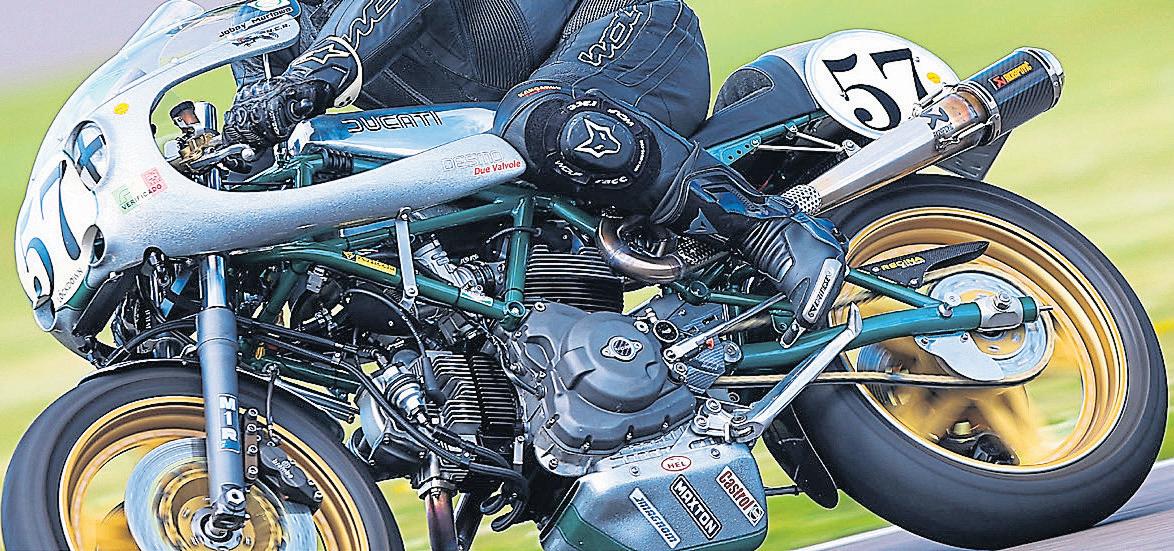













SHARK THE HISTORY
Founded by former professional racers, the French firm based in Marseille employs over 700 dedicated staff to ensure the highest level of quality of its produce. With a focused ethos to push technical boundaries, assisted by a continual investment into innovation (8-10% of its turnover, in fact…), SHARK regularly launches new, groundbreaking designs. It was the very first helmet brand to introduce integrated LED lights, with the introduction of the SKWAL in 2015. The helmet helps boost the visibility and safety of its wearers by having its LEDs displayed either constantly, or flashing on and off. The eye-catching feature also offers a great way of looking cool! Another highly notable achievement for SHARK came in 2011 with the introduction of the EvoLine. The first flip-style helmet to be homologated as both an open or full-face design, it was unarguably ahead of its time.
Then in 2013 the iconic, highly distinctive, DRAK came to market. An aggressively styled open-face helmet with goggles and rubber face mask, it turns the heads of all who view it. The following year, SHARK launched the highly versatile Explore-R. Incorporating a removable peak, it also gives the option to ride with goggles or visor.


For 2023, the brand-new SKWAL i3, as well as its forward-facing LEDs, also features the addition of intelligent active brake lights as standard. Designed without the need for a Bluetooth connection or wires, the industry-leading tech uses an in-built triaxial accelerometer to activate red LEDs on the rear of the helmet during braking. They flash three times a second during normal braking, and five times per second when braking harder.
By continually updating the range with fresh designs, colour options, refinements and improvements, SHARK ensures every SHARK-wearing road rider and racer alike can enjoy the pleasure and freedom from riding in total safety.
All SHARK helmets are designed in France and overseen by the firm’s advanced Research and Development department. Each one of them is a product of the unique ‘Reverse Engineering’ policy – a strategy further evolved with the brand’s latest helmets featuring SHARK’s ‘Best Fit’ – developed following a campaign of 3D head shape scans by the brand. A perfect example of SHARK’s innovative philosophy, it uses the rider’s head shape as the starting point.

Effectively, all SHARKs are made from the inside out. As well as this, the creative process also follows the ‘Designed for a Function’ motto. As a result, every line, curve and feature of the helmet must have a function and purpose which positively benefits the wearer. Innovative features such as the ‘Easy Fit’ design to enable riders with spectacles to ride in greater comfort, removable and washable interiors, and linings compatible with SHARKTOOTH Prime –SHARK’s wireless and universal communication and entertainment system – are all beneficial features that underline SHARK’s aim to make a difference to the overall experience of the wearer.
Thanks to the connection of its founders, racing has very much been in the DNA of the SHARK brand. With vital importance placed on rider safety, it’s not enough to simply meet safety standards, the constant ambition is to exceed them. A clear example of this was underlined when the announcement was made that helmets were required to meet the international racing body’s FIM-dictated new FRHPhe-01 homologation ruling. SHARK’s response was to act quickly, becoming the world’s first brand to achieve the homologation, in all sizes in the new Race-R PRO GP FIM Racing #1 range.


With over 30 years of experience, and a proven reputation for protection endorsed by Grand Prix champions such as Jorge Lorenzo and Johann Zarco, SHARK Helmets can justifiably claim to be a global leader in helmet manufacture.
WORDS: Chris Moss PHOTOGRAPHY: SHARK
26 ADVERTORIAL
Alban Rojas, SHARK’s research and innovation manager, said: “SHARK Helmets has been relying on motorcycle racing to boost brand development ever since its creation. We are very proud to be one of the first brands in the world to receive the new FRHPhe-01 homologation for our flagship model, the Race-R PRO GP FIM Racing #1.”

Teamed with the very best riders, including many from all the major world championship classes, SHARK naturally benefits hugely from feedback from some of the most demanding environments. This unbeatable information boosts SHARK’s relentless research and development programme across the
TIMELINE

1989: SHARK founded in Marseille, France
1990: 1st motorcycle helmet to ever feature carbon fibre shell structure
1999: SHARK-supported rider, Carl Fogarty, wins his fourth World Superbike Championship (1994, 1995, 1998 and 1999)
2005: BSB Championship winner – Gregorio Lavilla
2007: Innovative EvoLine launched – flip-front, dual homologated helmet
2013: Launch of iconic DRAK
BSB Championship winner – Alex Lowes

SHARK has also had 75 World Champions – they achieved this in 2022 with Alvaro Diaz in the World Junior Supersport Championship
2015: World’s first helmet with integrated LEDs launched by SHARK – the SKWAL
2016: Jorge Lorenzo signs with
SHARK
2018: A brand-new off-road helmet joins the range, the Varial
2019: SHARK introduces the first FIM racing homologated helmet for circuit racing – the Race-R
Pro GP FIM
2019: SHARK-supported Scott Redding wins BSB Championship
2020: Launch of innovative EVOJET – open-face helmet with chin guard and visor one attached unit – and world’s first iridium visors certified for day and night use
2022: SHARK introduces the UN ECE 22.06 compliant Spartan RS. SHARK-supported Bradley Ray wins BSB Championship, and Jorge Martin achieves the top MotoGP speed record in Italy with 225.18mph wearing the Race-R Pro GP
2023: SHARK produces the SKWAL i3, the first helmet with integrated red rearward-facing LED brake lights
whole range of helmets, improving the safety and performance of each and every SHARK sold anywhere in the world.
Alongside the support for professional racers, in 2019 SHARK signed a multi-year deal as title sponsor for the French round of MotoGP, resulting in the world championship event being titled the ‘SHARK Helmets Grand Prix de France’ held at Le Mans.

With a total of 25 helmets in the SHARK model range, there’s a helmet to suit every rider and budget – full-face, open-face, and everything in between. It doesn’t matter whether riders are looking for the topof-the-range Race-R Pro GP, priced at £1049.99, or a
full-faced Ridill, costing £119.99, there’s a choice for literally everyone.
Sold in over 5000 resellers, across 77 different countries, SHARK Helmets are distributed by Nevis Marketing in the UK. To find your local authorised SHARK dealer, visit: www.nevis.uk.com or call 01425 478936.

www.nevis.uk.com SHARK 27
There’re around 2000 miles of motorway in the UK – but believe it or not, there’re actually three times as many miles of green lanes that you can legally ride on two wheels. So to help you hit the trails with confidence, here are some of our top tips to help keep you smiling on the rough stuff.

STAND UP AND LOOK UP
If you’re riding off-road, you need to get comfortable with riding while stood up on the pegs. It’ll help improve your forward vision and force you to focus beyond your front wheel and avoid fixing on a target (and subsequently hitting it). That’s not all, as it’ll also help offer better control, as the bike can move more freely beneath you and soak up bumps and lumps more easily. Ensure your knees are straight (but not locked) and your elbows are out to help you and the bike work in unison.
BE PREPARED
You never quite know what to expect when you’re on the rough stuff, so you’ve got to be ready to react to changing conditions quickly. In practice, that means you should be covering both the clutch and front brake with one or two fingers so you’re ready to take some speed off in a hurry should you need to. You can feather the clutch and drive away instantly when riding into a corner or making a sharp manoeuvre – and then release the clutch and accelerate out.
RELAX
Like riding any motorcycle you need to try and stay relaxed. Don’t hold onto the bars too tightly, and don’t tense up when you approach an obstacle. Focus on being as smooth and fluid with your movements as possible. When riding stood up, your arms should be relaxed, with elbows out and your palms down – and your legs should be straight but not locked.
28 KNOWLEDGE
FORGET THE FRONT BRAKE
Braking off-road is a much different experience to on the Tarmac – hard, aggressive braking isn’t going to end well unless you really know what you’re doing on the dirt. Instead of using the front brake for around 80% of braking, you should be using both your engine and the back brake to take speed off. It’ll be strange to start with, but with a bit of practice you’ll soon get the hang of it.
WHERE TO RIDE
It’s not always easy to find legal lanes and byways, particularly if you haven’t got much knowledge about the area you’re exploring, but thankfully, there’s still a lot of fun to be had if you know where to look. The big questions are whether your bike’s suitable and you’re a good enough rider to tackle what could potentially be some seriously tricky terrain. There are a number of ways you can find out about where you can legally ride ‘off-road’ in a particular part of the country. First there’s the TRF. The lads (and lasses) at the Trail Riders Fellowship are always happy to help with advice and guidance, and you might even be able to join a regular ride-out with a group of members.
KNOW THE RULES
Strictly speaking, trail riding is not ‘off-roading’. All routes used are public highways with vehicular rights, and as a consequence, both bike and rider must be fully legal. By law, motorcycles are allowed to ride on Byways Open to All Traffic (BOAT) and Unclassified County Roads (UCR).

There’s little better than being shown around by a local, but if that’s not an option, you’ll have to take some time and do a bit of research. Get yourself a (recent) OS map of the local area and consult it to find out where to find the unclassified roads and byways open to all traffic. These are the ones you can ride. There’s TrailWise, too, a great resource for routes providing you’re a paid-up member of the Green Lane Association. You can also check out forums, consult YouTube and do a bit of internet digging and, best
of all, speak to people. You never know, that chap sat in the pub might know of the best lane in the area. You’ve only got to ask.
There’s also the TET
The Trans European Trail is exactly what it sounds like: a whopping series of legal byways that stretch right across Europe (and beyond). There’re a whole load in the UK which stretch from the south west up to the north east, but it actually maps out over 31,000 miles of dirt roads from the northern tip of Africa to the Arctic Circle. If you want to know more, the TET website is the place to go. On it you’ll find downloadable GPX files (for each specific country), which can be to your phone, tablet, PC or GPS device. There’s also an Android app which you can download straight to your phone and access and download all of the routes with a couple of taps. It’s very easy to use, and if you activate GPS location services, you’ll even be able to see where you are in relation to the next trail. The route can be fairly challenging and is aimed at small and mid-capacity trail bikes, but a capable rider should be able to enjoy him(her)self on a bigger machine. If you don’t fancy a section, you can usually turn around and take a Tarmac detour to the other end.
KNOWLEDGE 29






OLD SCHOOL
COOL
A.J.S. might be one of the most iconic names in British motorcycling. And despite a tumultuous past, it’s still building bikes – including this stylish pair which hark back to its glory days as one of the biggest names in off-road racing.

A.J.S. has been around a long time. Those with an interest in the history of motorcycling will be pretty familiar with the story, but if that’s not you, then here’s a very brief potted history of the iconic bike brand.
Founded way back in 1909 by the Stevens brothers, the family firm built up an enviable reputation for quality engineering and racing prowess, before being acquired by Matchless Motorcycles in 1931. Good times followed, with the creation of a whole host
WORDS: Ross Mowbray PHOTOS: Gary Chapman
of famous models including the 16MS, 18MS, Model 20, 30, 31, CSRs and the ‘Boy Racer’ 7R – but in 1966 A.J.S was absorbed into the Norton Villiers group. Off-road success quickly followed, with Malcolm Davis winning the British 250 Championship on an A.J.S. Y4 250 in 1968.
In 1974 the ownership changed again, but this time it was A.J.S. Competition Manager Fluff Brown who claimed the name, buying all the factory’s Stormer spares from Norton Villiers and starting production of A.J.S.
Stormer-based machines. Today, A.J.S. is looked after by Fluff’s son Nick, and although they’re still big into Stormers, their bread and butter is now funky, retro-styled imports which pay homage to some of the most memorable bikes in its history. And that’s where these two 60s and 70s-inspired scramblers come in… We spent a few weeks putting them through their paces both on- and off-road to see if they go as well as they look. Here’s how we got on.
FIRST RIDE: A.J.S. TEMPEST SCRAMBLER 125 AND ’71 DESERT SCRAMBLER 125 31
TEMPEST SCRAMBLER
The learner legal scrambler market is massive. If knobbly-tyre clad 125cc machines are your bag you’re properly spoilt for choice – but to find one with actual heritage like this A.J.S. isn’t so easy.
Okay, so just like the Heralds, Mutts and Mashs of this world, the Tempest Scrambler (and the ’71 Desert Scrambler) is an import from China –but with ties to its 70s scrambling past and a passion for trail riding, the team behind the bike know what they’re after and know how to deliver.

What that means is the bike is pretty bloody good. I’ve actually ridden one before. When it was first introduced back in 2020, we nabbed it for a couple of weeks and a colleague put it to the test. It impressed, proving itself incredibly useable, surprisingly refined and unapologetically stylish. And so when I got the call asking if we’d be up for riding it alongside its new scrambler sibling, I jumped at the chance.
The Tempest Scrambler has nearly all the right stuff: knobbly Kenda rubber; braced bars; retrostyle numberboards; a headlight grille; twin-shocks at the rear; and a centrestand. The only slight disappointment is the low-slung exhaust. In keeping with its retro aesthetic, there’s very little in the way of modern conveniences. The clocks are straight out of the 1970s, there’s no ABS and it even does without LED lights. I like that.
Despite its lack of mod-cons, it’s a lovely place to be. With a 780mm high quilted seat, wide-enough bars and a nice neutral but upright riding

TECH SPEC
The Tempest Scrambler
Price: £2899
Engine: 124cc single-cylinder SOHC, air-cooled
Power: 9.5bhp @ 9000rpm
Torque: 7lb-ft @ 6000rpm

Transmission: 5-speed
Frame: Tubular steel
Suspension: (F) Telescopic forks (R) Twin shocks with pre-load adjustment

Brakes: (F) 300mm disc, linked (R) 210mm disc, linked
Wheels/Tyres: (F) 4.10/18 (R) 4.60/17
Seat height: 780mm
Weight: 124kg (dry)
Fuel tank: 16 litres
Warranty: 24 months
Contact: www.ajsmotorcycles.co.uk
position, I’d happily have spent all day bombing about at the helm. It’s light, too, tipping the scales at just 124kg, which makes it a doddle to shift around (or even pick up if you get into some trouble in the dirt).
The engine’s not exactly potent, but it feels solid and surprisingly smooth for a single. It’s actually the same unit as Yamaha’s nearbulletproof YBR 125. Rebadged for A.J.S. but manufactured in the very same factory, I reckon that bodes well for how it’s going to stand the test of time. It kicks out a respectable 9.5bhp at 9000 rpm and 7lb-ft at 6500rpm, which is enough to see 50mph on the clocks without much effort – though you’ll have to work the five-speed gearbox hard and hold on to the speed through corners to get up to 60mph.
Stopping is looked after by single discs at the front and rear. Because there’s no ABS, they’re linked, which essentially means the right-hand lever operates the front independently, and the right-hand pedal blends the front and rear. It’s nicely set up, and there’s plenty of


progressive bite to help haul the bike up in a hurry, with enough feel to allow for gentle application and tight turns in town. The front forks and pre-load adjustable twin shocks are pretty basic, and although they’re very soft as standard and you’ll quickly bottom them out if you hit anything hard, they offer a neat balance of comfort and performance on the road. It handles well – and I immediately felt comfortable throwing it around on the road, even if the knobbly Kenda tyres were squirming a little under the pressure. The rubber’s a nice addition, and offers a decent compromise between road and off-road. Even in wet, slippery mud I had no real issues with traction. Of course, it’s no enduro machine and without a bigger front wheel you’re going to struggle to tackle anything too challenging, but that doesn’t mean there’s not a whole load of fun to be had.

32 FIRST RIDE: A.J.S. TEMPEST SCRAMBLER 125 AND ’71 DESERT SCRAMBLER 125
’71 DESERT SCRAMBLER
Following the success of its Tempest Scrambler 125, A.J.S. has decided to take things a step further with a bike inspired by its 14th place finish in the legendary Mojave Desert race in 1971.
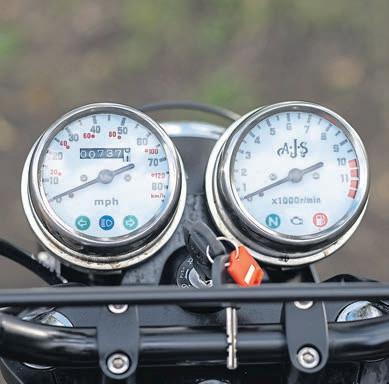


Riding an A.J.S. Stormer, A.J.S. competition manager Mike Jackson brought it home against an incredible 3200 racers, tackling a gruelling 190mile course of deep sand, steep dunes and a snowy mountain pass. And while the new ’71 Desert Scrambler might struggle to handle such tricky terrain, it’s still got plenty going for it to help entice riders young and old to part with their hard-earned cash.
As you’d probably expect, given its ties to a seriously capable racer, the ‘71 Desert is the most off-road capable of the range. Don’t get me wrong, it’s not going to be winning any rallies – after it shares plenty with the Tempest, though there are enough differences to help make it a different proposition entirely.
That’s partly because the factory has made a whole load of tweaks to help its prowess in the dirt, from repositioning the footpegs and adding a stronger rear brake pedal, to fitting an upswept stainless steel wrapped exhaust and a slimmer fuel tank. That said, it’s still a compact little bike with the same 780mm seat height as the Tempest – and anyone over 6ft tall is likely to struggle to get comfortable when stood up on the pegs. It’s much better to think of it as a funky street scrambler – and then you’ll probably
be surprised by just how much fun it is to ride on the trails.

And it is fun. A lot of fun. It’s the bike I rode the most of the two – partly because of how good it looks; partly because I didn’t have to worry about bashing the exhaust on rocks and ruts (like I did with the Tempest); and partly because it felt much more like a traditional scrambler should.

It uses the same Yamaha YBRderived 4-stroke, single-cylinder engine as the rest of the A.J.S. Heritage range, and like I said before, while it’s nothing really to write home about it, it’s pretty perfect for the little bike. I’m used to blasting about on much bigger, more powerful machines, but I found my groove quickly and thoroughly enjoyed bombing about on B-roads and back lanes without feeling like the bike was wanting.
Just like the Tempest, it was softly sprung enough to soak up all but the worst of the chewed-up Lincolnshire roads and bound over lumps and bumps off-road without bottoming out – and yet I had no trouble trying to get it settled under heavy braking on my way into a corner either. Basically, it handles well. What more could you ask for? It stops well, too, and even my most ham-fisted of braking manoeuvres did little to unsettle it. That’s good news for learners.
If I was 17 again I’d be seriously thinking about splashing the cash on this bike. It might not have quite the
same level of refinement as something from one of the big names in the game, but what it’s missing in polish it more than makes up for in character and neat, well-thought-out touches – like the handy tool box which comes strapped to its side, the Kenda tyres, and the kickstarter. I’m quietly hoping A.J.S. sticks a 250cc engine in the same chassis and a 19-inch wheel up front, because that would surely be an absolute hoot.

TECH SPEC
Desert Scrambler Price: £2899 Engine: 124cc single-cylinder SOHC, air-cooled Power: 9.5bhp @ 9000rpm Torque: 7lb-ft @ 6000rpm Transmission: 5-speed Frame: Tubular steel Suspension: (F) Telescopic forks (R) Twin shocks with pre-load adjustment Brakes: (F) 300mm disc, linked (R) 210mm disc, linked Wheels/Tyres: (F) 110/70-17 (R) 130/70-17 Seat height: 760mm Weight: 126kg (wet) Fuel tank: 13 litres Warranty: 24 months Contact: www.ajsmotorcycles.co.uk
The
FIRST RIDE: A.J.S. TEMPEST SCRAMBLER 125 AND ’71 DESERT SCRAMBLER 125 33
FIRST RIDE: A.J.S. TEMPEST SCRAMBLER 125 AND ’71 DESERT SCRAMBLER 125

SIMPLE PLEASURES
There’s a lot to love about these two stripped-back bikes from A.J.S. It just goes to show you don’t need a tricked-out enduro machine or a fully loaded adventure bike to get out and explore. Sure, they might not be the most sophisticated or the most capable, but I had a huge amount of fun belting around on back roads and green lanes on this pair of super-stylish machines.
Of the two I probably preferred the Desert Scrambler, though that’s primarily thanks to its upswept exhaust helping it look the part The Tempest Scrambler is probably a more usable machine – slightly taller, slightly more comfortable, a bigger fuel tank, and that bright orange paint job is damn cool in my book
But in truth, the differences are fairly minor and I suspect any new riders (or more established riders
Price: £2899
Engine: 124cc single / 9.5bhp / 7lb-ft
Fuel tank: 16 litres
Seat height: 780mm
looking for a funky little runaround that’d not look out of place cruising around Middle England or blasting through Shoreditch) would find plenty to like about either
It’s also clear the guys at A.J.S. actually ride their own bikes That might seem like a strange thing to say, but I’ve spent time on my fair share of learner legal ‘budget’ scramblers and none have been quite as well prepared as these two From the quality Kenda rubber to the neatly designed adjustable levers, the little things really do make the world of difference – and the fact that they've been raced at the Malle Mile and been taken out scrambling on Salisbury Plain gave me confidence that the bikes would be up for taking a bit of a beating on the trails I think that speaks volumes, don’t you?
Price: £2899
Engine: 124cc single / 9.5bhp / 7lb-ft
Fuel tank: 13 litres
Seat height: 760mm
34























































Cost-effective Classics

SUZUKI RF900
Bargain-basement cost with missile potential and mega miles capability
After a regular fix of retro biking goodness? Classic Motorcycle Mechanics is the magazine for you, with a hearty mix of road tests, buyers’ guides and workshop wisdom on some of the best bikes of the 70s, 80s and 90s.

36
COST-EFFECTIVE CLASSICS
Rated four out of five or better on numerous websites for performance, quality and equipment, it’s the sub£4000 bike with a 160mph potential. Sold as a ‘budget bike’ back in the late 90s, there’s little that’s shabby about this bike! Tough as they come, reliable, torquey, hugely capable and comfortable, Suzuki’s RF900 ticks so many boxes.
Background
This machine is Suzuki’s quickthinking response to the mega bikes of the late 1990s and is none the worse for being rolled out to dealers pronto. Cost-wise, craftily pitched significantly below Yamaha’s FZR1000 and Kawasaki’s ZX-12R, the RF900 utilised an engine that owed much to the GSX-R1100W. The steel chassis helped to keep costs down even if some of the early models had the perimeter frame painted the same colour as the panels. Made as a fill-in, do-anything bike somewhere between



Ferrari Testarossa louvres and that broad derriere, there is a lot going on with this month’s subject matter.
Yes it was built down to a price, didn’t come all stickered up with flashy acronym decals, and ‘only’ has a steel frame, but there’s a lot more to the RF900 than meets the eye.
135bhp of power and 70lb-ft of torque isn’t to be sneezed at and the motor’s flexibility will still impress even now. Owners rave about just how tractable the motor was and when you realise its GSX-R derived transmission has only five ratios instead of the Gixxer’s six you can begin to appreciate the work Suzuki undertook to get the bike’s engine bang on.
Want some reassurance you won’t be buying some lame old dog just because it’s cheap? In 1993 Suzuki Germany, supported by Metzeler and the German motorcycle magazine Motorrad, worked together to deliver four endurance records over one, six, 12 and 24 hours. Any motorcycle that can run for an entire day and average more than 152mph consistently has to be extremely well made. Still not sure it’s a bike worthy of consideration?
The RF900 has been variously stroked back to 1100 and some ccs; has been supercharged; turbo charged; sprinted; drag raced; tuned; tweaked; turned into a track day machine; and just keeps on coming back for more. Be under no illusion, this is a seriously strong piece of kit! Oh, and know that some have used the RF900 as a track day machine and seriously embarrassed Yamaha R1s!
Faults and Foibles
1. BRAKES
More than up to the job but like all calipers they benefit from a service. Sintered brake pads are recommended by owners.

2. EXHAUSTS
Front pipes can get shabby very quickly but they are stainless steel. Mounting bolts can and will seize/
break/snap if not treated with easing fluid.
3. CORROSION
Peripherals can and will corrode so invest in some good spray protectants if you’re riding through the winter on the RF.
4. FUEL SYSTEM
Stale petrol in the
carbs, fuel lines and carburettors will cause running issues. If you’re buying a ‘laid-up’ example, factor this in.
5. TRANSMISSION
Some bikes were said to have second gear issues so check it selects okay and stays in gear under hard acceleration.

6. SUSPENSION
Rear shocks can go soggy, ’95 and on models have adjustable forks.

7. PANEL WORK
Check fairing side panel louvres for damage and/or bodged repairs.
1 2
3 4 5 6 7
COST-EFFECTIVE CLASSICS 37
The engine is used as a stressed member within the steel perimeter chassis which delivers quality handling despite the supposedly budget-end suspension.

Some have criticised the spring rates as being too hard but 20 years on things will have softened up a little. Yes, okay, the RF won’t hustle through bends like a modern sports bike but it’ll give its contemporaries something to think about.
Some love the big, broad saddle while others aren’t fans, but
it’s an easy fix with a few firms offering alternatives. It’s all down to physiology as some riders rate the OEM seat as 1000 miles a day comfortable.
If ever there was a hugely capable bike at a bargain price then Suzuki’s RF900 has to be the one!

Lineage and Legacy
Nothing much came after the big RF in terms of ease of use, power and handling until we got into the 21st century. The advent of modern,
multipoint, monitored, fuel injection delivered similar levels of flexibility and drive. Probably the closest you get from the firm is its new GSX-S1000GT – but it’ll set you back ‘12 large’!


Why you might want one now
Price has to be the first driver for owning an RF900, swiftly followed by real-world usability, decent longdistance capability, versatility and, of course, that stunningly good engine. Suzuki made the air-/oil-cooled four cylinder its own with the very first GSX-Rs and carried on with fully liquid-cooled bikes like the RF900 here. Owners swear by them and for the money they are truly hard to beat… at the moment. There’s been a slow but inexorably subtle price rise going on with decent RF900s so if you want one get in ASAP.
Typical Prices
Oh, you are going to love this one because it’s easily inside our selfset five grand budget. At the time of writing, eBay had two RF900s up for less than £4000 and both were in remarkably good condition. One with just over 17k on the odometer was at £3750 but we reckon that was always going to be a £3500 steal.
If you’re budget is tighter a very tidy example on 29,000 miles was tantalisingly being dangled at £2750 and, again, there was a bargain there if you were prepared to haggle. We’d suggest swerving a project RF900 quite simply because good ones are still so ridiculously cheap!
Summary
All of this with the performance of a genuine sports bike and the comfort of a tourer can be yours for under four thousand pounds. Predictable handling that’s more than good enough for most riders’ abilities, the RF900 is sure-footed but nimble and the right side of flighty. With enough power to get you into and out of trouble, there’s really little else that matches up for the money.
38 COST-EFFECTIVE
CLASSICS


 Danny McFadden
Danny McFadden
Ever thought about mixing it up on track? Don’t know where to start?
LET’S GO RACING
This month we’re going to focus on bike set up. We’re also going to take a look at bike modifications that will be required now that you’ve decided to give this racing thing a go, in addition to giving you a few ideas for some more that’ll make you quicker, safer and more slick in the paddock

Whether you’re running a new or secondhand bike, one of the most often overlooked issues is checking that your bike is in fact straight and true. I was caught out with this during my rookie year when I purchased a secondhand race bike in a hurry to replace my damaged bike from the Snetterton incident I mentioned last month. Despite it being the same model as my previous bike, I spent the first part of
the season really struggling, which initially I attributed to adjusting to riding with an injured arm. However, after several rounds and a strange ‘off’ I finally decided to have the frame checked. Unfortunately, it was found to be a complete write-off. Although not the news I wanted to hear on a financial basis, it did help to restore my confidence which had been eroding away with every difficult round. This is something I have seen multiple times in the paddock, where people have changed bikes and spent a long time battling with it, all the while losing confidence and the fun with it. Even brandnew bikes can be out of tolerance and a trip to a company like GTR (George Thomas Repairs) in Lincolnshire hopefully will
confirm all is well and if not in most cases can realign the frame/yokes/swingarm/rear subframe and even wheels back to tolerance
In order for these checks to be made, the bike needs to be reduced to a rolling chassis with engine. Although this can be daunting for many to strip a bike down to this level, I would advise it to be the perfect opportunity to learn how to strip and rebuild your chosen bike. Bike maintenance is a massive part of racing, both for safety and breakdown avoidance. Being able to clean and strip your bike is a fantastic way of catching issues as they develop and to ensure should anything arise during a race weekend you are able to deal with it swiftly and efficiently. Owners service manuals are
available for free online for most bikes and should be read and used to obtain such vital information as bolt torque values. Writing a list of the major ones (e.g. brake caliper bolts, wheel spindles, nuts, fork pinch bolts, frame/subframe bolts, etc.) to reference throughout a racing weekend is also good practice
Wiring issues are also fairly common on race bikes, either age-related wear to connectors, earths and components, or damage caused from crashes or excessive rubbing/movement. Another benefit of regularly stripping your bike is the ability to spot things early and make adjustments or repairs to these areas and hopefully avoiding issues during the race weekend itself
40 KNOWLEDGE
WORDS and PHOTOS:
Don’t worry, our man in the paddock is on hand to fill you in on exactly what you need to know if you fancy becoming part of the vibrant club racing scene in the UK.
THE MAN IN THE PADDOCK
Danny McFadden’s not been racing long. After a long break from bikes he was bitten by the track day bug a few years ago, before making the leap and starting racing in 2021. He entered the Rookie 1000 grid with British Motorcycle Racing Club, and ended up a very respectable 6th overall in the Championship. Various issues tested his resolve throughout his rookie season, and taught him a lot about the pitfalls of secondhand bike purchases. But with a season under his belt and a new bike in the

TOP TRACK-BASED TWEAKS
My general thoughts on bike upgrades when starting out is that its tempting to go out and replace everything on your bike with high-performance upgrades and end up with something that is so far out of the working window for your own ability, that you can end up fighting with a bike rather than gelling with it If you start out with basic upgrades and only upgrade one specific area at the correct time you allow yourself to fully take in the new upgrade in isolation Rinse and repeat until you have your own perfect race bike. Here’s some of the things I’ve done and some of things I’ve learnt Riding position: Handlebars, rearsets and seating position. This is often overlooked with people opting to spend money and time on other performance-enhancing items rather than focusing on making the bike fit you. The more comfortable you are in your riding position the better you will ride. As with riding equipment (more next month), time spent on adjusting the bike to put you in the best riding position will reduce fatigue and in turn allow you to focus on the riding. As well as clip-on and foot peg position, time spent adjusting gear lever angle/span, hand lever span/ height and even seat pad height/ depth can reap significant benefits for
BRUSH UP
If you’re serious about going racing, it’s worth reading the current 2023 ACU road racing technical regulations (www.acu.org.uk) along with contacting the club you have decided to try your first event with for any additional requirements they may have. Should you be able to, I would also recommend taking your bike to a round in advance of your first race weekend (along with your riding gear) and going through the scrutineering process. This could be arranged in advance with your chosen club and would allow the technical inspectors to run through everything with you, either passing your bike or providing you with a list of changes needed to pass along with plenty of advice on how to achieve them.
THE ESSENTIALS
garage, Danny entered the Pirelli Super Series for 2022. Taking part in both the Premier class and the ACU Clubman 1000 Endurance class with No Limits Racing, he finished 10th and 3rd respectively. And now he’s ready for 2023, with the support of Sycamore Yamaha in Uppingham, EBC Brakes, HEL Performance and HelmetCity co.uk Expect lots more from Danny over the coming issues, and if you’re ever at a Bemsee round be sure to go and say hello He might even persuade you it’s time to dust of the leathers yourself...

relatively little outlay. Consideration also should be given on the type of screen fitted in order to best reduce wind pressure, buffeting and noise
Brake upgrades: Direct to master cylinder stainless brake lines coupled with race pads and regular fluid changes can significantly improve the performance of most systems I would recommend a thorough service of your existing calipers/ master cylinder (inc. seals/pistons if required) and if your current discs are within specification, start your racing journey with this set up and only upgrade as the need arises
Suspension: As with your brakes, a minimum should be a full service of both front and rear suspension ideally with a change of springs to suit your weight/riding will again ensure everything is in good working order. After this, a rear shock is often considered the most important first upgrade as standard shocks are often the weakest link and the benefits of a quality upgrade will be significant both in terms of handling and tyre wear. As pace requires or funds allow, a front suspension upgrade
again can dramatically improve the handling of the bike but will also often require significant time in finding a setting window that works. If buying secondhand items I would again advise having a full service and spring set up carried out to ensure you’ve not bought something with pre-existing faults
A good-quality adjustable steering damper is also a very advantageous upgrade and once again if bought secondhand should be checked and serviced to ensure all is working as it should be Lighter weight chain conversion and a selection of sprockets (e.g. 520 pitch). Ignoring the performance benefits of the lighter chain and sprockets, the best advantage of this modification is the ability of being able to alter gearing from track to track. Depending on the power of your bike, this can find significant lap time reductions and rider fatigue by reducing unnecessary gear changes and/or keeping the engine in the correct rev range at corner exits Frame/swingarm protection: Worth their weight in gold if you have even
a small off. Gravel rash to either can seriously reduce a bike’s saleability. There are many more small modifications that can make a big difference during a race weekend, including fitting angled tyre valves to stop you burning your hands on your brake discs every time you want to check/adjust your tyre pressures; captive wheel spacers/rear caliper bracket to speed up wheel changes; and an accessible battery charger lead which allows you to easily place your bike on charge at the end of each day.
Here’s a brief breakdown of some of the key stuff you’ll need to do to meet the regulations and go racing:
■ Engine crash protection, lockstops and brake lever guards (e.g. GB racing)
■ Shark fin chain guard (e.g. GB racing). Stops riders’ appendages being caught inbetween the lower chain run and the rear wheel sprocket.
■ Race bodywork: This must include a sealed belly pan capable of holding your engine fluids should a leak occur. Most race fairing kits on sale meet these requirements.
■ Lock wiring: The minimum requirements for this are the oil filter. This can be done using a metal jubilee clip around the filter, with a lockwire running from this to another fixed point such as an existing bracket.
■ The second minimum requirement is the oil filler cap itself. This is often achieved by drilling the corner of the filler cap along with another hole in the nearest engine crash cover and lock wiring the two together
■ The third minimum requirement is the oil sump bolt. I would recommend purchasing a predrilled magnetic sump plug which will give you an added benefit of monitoring engine wear during oil changes. As with the oil filter, this can be lock wired to a pre-existing fixed point or alternatively most engines have a cast ‘tang’ near the sump bolt which can be drilled for such a purpose.
■ Although lock wiring can be highly technical and an art form in itself, the basic level required for racing can be learnt relatively easily with some practice. There are lots of online videos on the subject. The most crucial part is to ensure the tension between the two points is pulling in the correct direction to keep the fitting(s) tight.
■ Kill switch: An ignition cutout must be fitted. This ignition cut-out system must interrupt the primary circuit and must be wired for both the supply and return of the current.
■ Rain light: All motorcycles must have a functioning red light mounted at the rear of the machine to be used in rain or low-visibility conditions as instructed by Race Control.
■ Breather pipes (Oil/Fuel/ Coolant): If applicable to your machine, these should be discharged into catch bottles and in case of a fuel tank breather, complemented with a one-way non-return valve.

■ Race number boards: These vary in colour (background and number) depending on chosen class; ACU regulations will inform you which you should use.
■ Noise limit: Race days and official test day noise limit is 105DB. However, some test days are run under the circuit’s track day officials and can therefore often be set at a lower limit.
■ Transponder: You can either purchase your own or rent one on a per round basis from your chosen club.
KNOWLEDGE 41
Track Rider Clinic
Which
Brands Hatch GP
Because I’m an old boy, Brands Hatch is still the home of WSBK to me. The late 1990s and early 2000s hosted some of the most exciting races with the biggest crowds, and the atmosphere was just electric; I’ve never attended a motorcycle event with the same vibe since, and it’s because the circuit flows and allows multiple riders to get in the same groove.
Key to riding Brands Hatch GP fast is firstly by being on the right line – where you turn in for each corner is the place to start – but once you have the line sorted, your next step is to work on your braking. For most race tracks you just focus on where to brake, but Brands Hatch GP circuit needs to flow, so it’s down to the amount of brake pressure applied; if you brake too hard then you lose momentum and then it doesn’t flow. Tips for riding a fast lap at Brands Hatch GP:
■ Get the line sorted, use the full track width at your turning, corner apex and exit points.
■ Work on your brake markers, then start to brake earlier with less pressure. Once you’re comfortable with this, go back to your original brake markers and brake with less pressure to keep the flow.
■ Find a gear pattern with the minimum amount of gear changes; for every extra gear you go up, that’s another gear to go down, and in some sections you will really benefit from holding the same gear.

Donington Park
You ride this circuit in two parts, with the first two sectors being very open and flowing, and the final sector being very stop-start and aggressive. I’ve probably done more laps of Donington Park than any other track and I never get tired of it; the wide run-off areas make for a safe environment for my coaching days and the split character of the track gives pretty much everything you need as a rider.
A good lap starts from the tip-in point at turn one. That may sound obvious but if you don’t nail the first corner you never get the time back because you need the drive and momentum into the fast and flowing Hollywood and Craner Curves sections.
I always liken the first half of Donington Park to road riding or road racing – not that it feels anything like the IOMTT, but because of the techniques needed to get it right.

Line of sight is so important – keeping your eyes up and towards your turn points will
Oulton Park
This is the most challenging circuit in the UK and by far the most difficult to learn, because after each corner the next section of track is completely blind. If you don’t know where you’re going, then you don’t ride naturally; you tend to be late on the gas and early on the brakes. This simply upsets your flow and it can become very frustrating.
Oulton Park flows in a similar way to Brands Hatch GP but the braking areas are a bit more aggressive. There’s turn one to tackle, a rapidly approached hairpin, two chicanes, and the fastattacked final turn that also requires some hard braking.
Each blind section is high speed and requires you to plan your turning points in advance. To get the best speed into Cascades you need to stay left on the approach to the brow and keep accelerating as you switch from the left to the right side over the brow. Clay Hill requires an accurate turn point at the bottom of the hill so you can stay accelerating over and past the brow. That will then set you up wide for the run into your next blind section at Druids.
take away that sensation of speed; it makes everything happen in slow motion. As an example, the slowest point at Craner Curves is between 100-120mph depending on the level you’re riding, but by keeping your eyes focused ahead, it doesn’t feel fast at all.
As well as keeping your eyes up and focused on the flow of the track, you need to stay connected through the throttle during the highspeed direction changes, so when you roll off for Craner or Starkeys, you should never fully close the throttle and that will really help with increasing your confidence to go faster.
After you exit the double apex corner of Coppice, you need to switch your brain into a different mode – you now need to push the brake points and use full brake pressure and make sure you’re hitting late apex points for Melbourne, Goddards and Redgate corners. Late apex points, slow corner speed, then get an early and aggressive drive out.
One of the most exciting corners at Oulton is the Shell Oils Hairpin which is a banked corner, allowing so much more corner speed than a regular flat hairpin. Normally I recommend avoiding coasting; you should either be on the gas or on the brake, but for a brief moment you can run into this corner so fast and let go of the brake on a closed throttle, allowing the camber of the corner to give you traction. When you get it right you can feel the suspension compress, and then you pick up the gas for the drive out. It’s awesome when you get it right.
In fact, all of these tracks are something special when you nail them. It takes time, patience and understanding to get the best out of any of these circuits and the same goes for the other great circuits we have here in the UK. Whatever effort is required, it is well worth it and my advice to you would be to learn how to get the best out of a track, studying the techniques and lines rather than just lapping it up. Not only will you go faster and ride safer, but also you’ll enjoy the experience even more.
For the ultimate one-to-one instruction, which includes everything from initial bike checks to video playback and on/off track tuition tailored to suit all abilities from a former WSBK racer, check out Dean Ellison Rider Coaching at www.ellison42.co.uk


POWERED BY
LEARN
FROM THE BEST
To book on a day with No Limits, check out www. nolimitstrackdays. com or call 01525 877087
is the best circuit in the UK for trackdays? Our pals at Fast Bikes spoke to top rider and top bloke Dean Ellison to get the lowdown on his three favourites from coaching and racing. They all require a slightly different riding technique to get a good lap in and each feels very special to ride at. Here’s what you need to know.
42 KNOWLEDGE
If you’ve got a penchant for bikes that go fast then our pals at Fast Bikes magazine will have something to tickle your fancy. Scan the code with your smartphone to bag an issue.











In theory getting up early to ride a couple of 125cc scooters in Milton Keynes wasn’t an exciting prospect.As a man who normally tests bikes with greater, higher-spec, and with far more performance, often in glamourous locations, I considered the status of the new Suzuki Avenis and Address scooters matched that of the more lowly positioned football team from whose pitch my ride would begin.
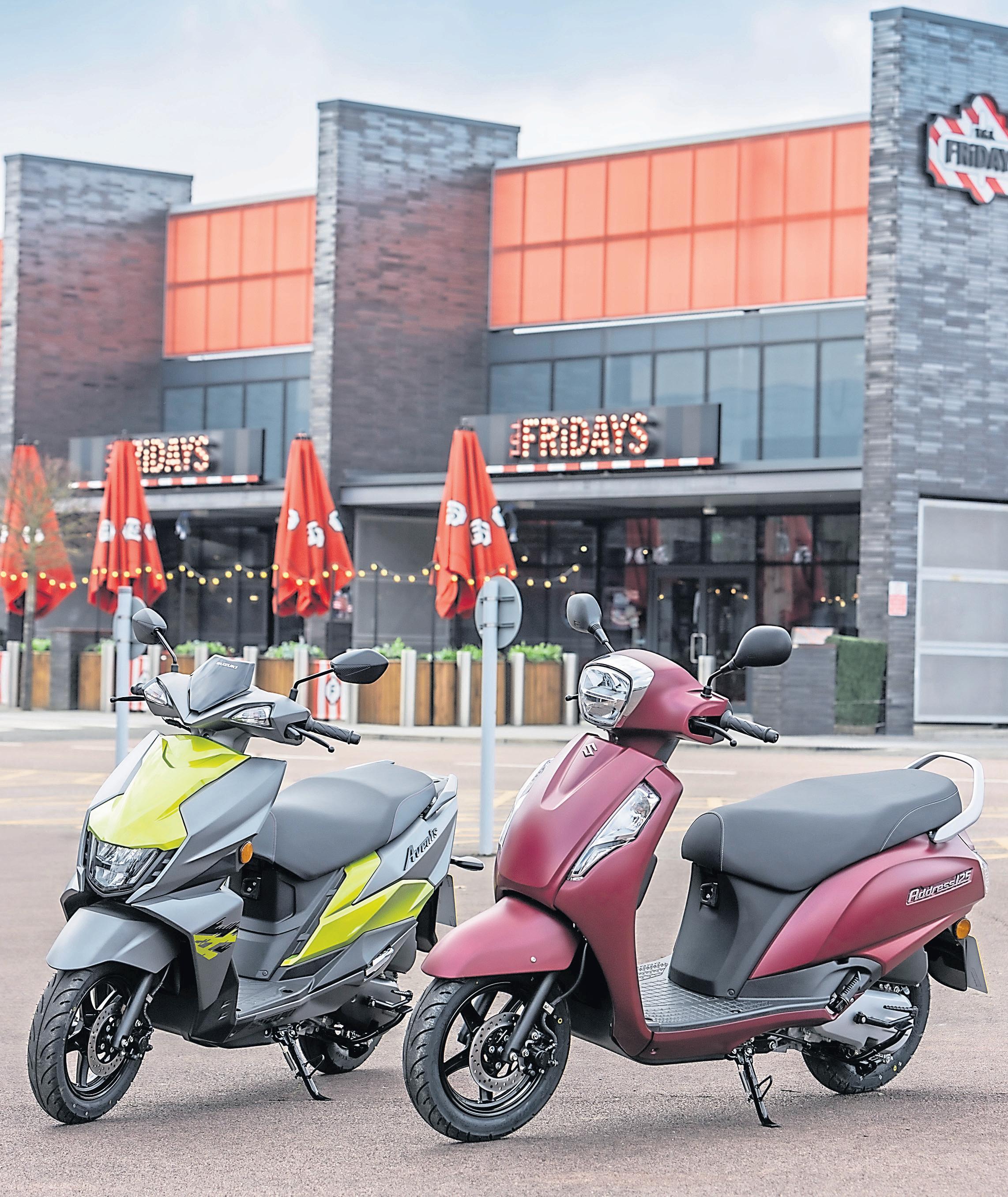
44 LAUNCH RIDE: SUZUKI AVENIS 125 AND ADDRESS 125
Stylish the two Suzukis may well be, but making just under 9bhp surely meant leaving the MK Dons’ stadium was going to be the start of a fairly dull and lacklustre day. How wrong I was. I began the test aboard the Avenis, and as the two machines are so similar, I’m going to concentrate on the riding experience of that model. The ride began encouragingly, and even before I’d left the football club’s grounds it was obvious I’d misjudged the potential of the Suzuki. Of course, I’d appreciated instantly just how light and easy it felt to ride, helped all the more by the simplicity offered by the automatic transmission. But what I’d clearly made an error in estimating was the performance of the 125’s engine. I suppose I could be forgiven for thinking that anything producing such a meagre level of power would inevitably result in a weedy turn of pace. But the stress from expecting to be at the mercy of the traffic was very much dismissed as soon as I turned the throttle for the first time.
Very prompt response from both the engine itself and the belt-driven CVT drivetrain that delivers the power to the rear wheel mean surprisingly spirited acceleration. Thoughts of an inability for the air-cooled single cylinder motor to cut the mustard in the Milton Keynes traffic were quickly banished. The fact is, the well-proven (with over five million sold worldwide) fuel-injected Avenis has a motor with excellent torque and flexibility, and I soon happily discovered it’s competitive with the traffic. Worries of having insufficient speed to pull away from a standstill at junctions and roundabouts cleanly and safely were put to bed, and the positivity and optimism grew from there. Not having to govern and meter things like gear choice and a clutchbiting point make things feel infinitely more straightforward, too. Just having to open the throttle to progress keenly really does make riding a conventional bike with a manual gearbox feel like a relative chore!
LAUNCH RIDE: SUZUKI AVENIS 125 AND ADDRESS 125 45



It wasn’t long before the route opened up, demanding a higher average speed to keep up with the traffic. But even so, I discovered the scooter copes way better than I ever thought possible. Okay, I need to put this performance into some context here, and in saying the Avenis has a decent turn of speed, getting you up to 50mph quite readily (and around 60mph ultimately), you still have to be wise and know your place.
TECH SPEC
Suzuki Avenis 125 and Address 125
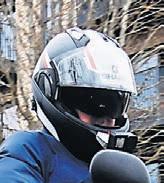



*Address in brackets
Engine: 124cc air-cooled, 2v, sohc, single
Frame: Steel-tubed double cradle
Suspension: (F) Telescopic forks, no adjustment
(R) Twin shocks, no adjustment
Brakes: (F) 190mm single disc, single-piston caliper (R) 120mm drum
Tyres: (F) 90/90 x 12 (R) 90/100 x 10
Fuel tank: 5.2 litres (5 litres)
Seat height: 780mm (770mm)
Weight: 107kg (105kg)
Price: £2699 (£2499)
Contact: www.bikes.suzuki.co.uk
WORDS: Chris Moss PHOTOS: Jason Critchell
In these days of impatient road users you still need to have your wits about you. It’s important to be very observant, especially via your mirrors particularly, and realise where you fit in the food chain. But there’s definitely no need to hug the gutter and hold everything up as you often see with some lowly powered twowheelers.
The Avenis has a decent, if not perfect, chassis to help let you get the best out of it, too. Very little effort is needed to manage this scooter, and the combination of its athletic 107 kilo kerb weight, and small diameter wheels, results in very quick and light steering. The tyres perform well, even in the wet, and though the linked brakes have good performance, you wouldn’t call it outstanding.
Suzuki Address
The other scooter I tested in and around Milton Keynes is the Address. Essentially, it’s equal in spec as the Avenis with the same engine and chassis, but has different, more traditionally styled bodywork and a slightly lower spec. It costs £200 less at £2499. Instrumentation is analogue compared to the
Overall though, the handling of the Suzuki is impressive. You really do have to recalibrate your physical input to prevent oversteering the 125. It really is a super-easy, very flickable machine and cutting through traffic couldn’t be much simpler. To be honest, it feels as though you only have to think about where you want to position yourself and, hey presto, the move is done. Again, a heavier bike seems to require much more effort to achieve the same result by comparison.
Now, life isn’t always perfect aboard the Avenis and reading the road surface is quite important to ensure a stable ride. The combination of the small diameter wheels and what amounts to the crude action of the suspension means some more serious
digital version of the Avenis and doesn’t display quite as much information. It doesn’t have a parking brake, has slightly less underseat storage space, and a smaller footwell. The Address only has one glove box style storage compartment, which doesn’t have a lid like the Avenis. Dynamic performance of the pair is very similar.
road imperfections can take over the Suzuki’s trajectory momentarily. During one of the photo sessions I ran down an especially knackered section of route and the scooter almost became possessed as the front wheel tracked along what appeared to be as deep as a gully. I wouldn’t have deemed it especially risky, and a bigger and better equipped bike may well have been influenced to some extent, too, but it was a reminder of both the state of some of our roads and the less-than-ideal reaction to such challenges the 125 can have at times. Mind you, it couldn’t prevent me having fun. There’s simply too much to like about the Avenis. It really does make the idea of public transport seem so unattractive. Having the freedom to travel as and when you fancy, do so at an absolute fraction of the cost and at a much superior rate of progress and convenience, renders travel on either a bus or train as wholly unattractive – well, for some of the shorter urban journeys anyway. Though I have to say, I didn’t write off the idea of riding the Avenis home, a journey of over 70 miles. For sure it wouldn’t have been especially luxurious, but on routes laden with lots of traffic, scooters like the Avenis make a hell of a lot of sense.
Suzuki claims the scooter’s capable of 148 miles to the gallon, giving a

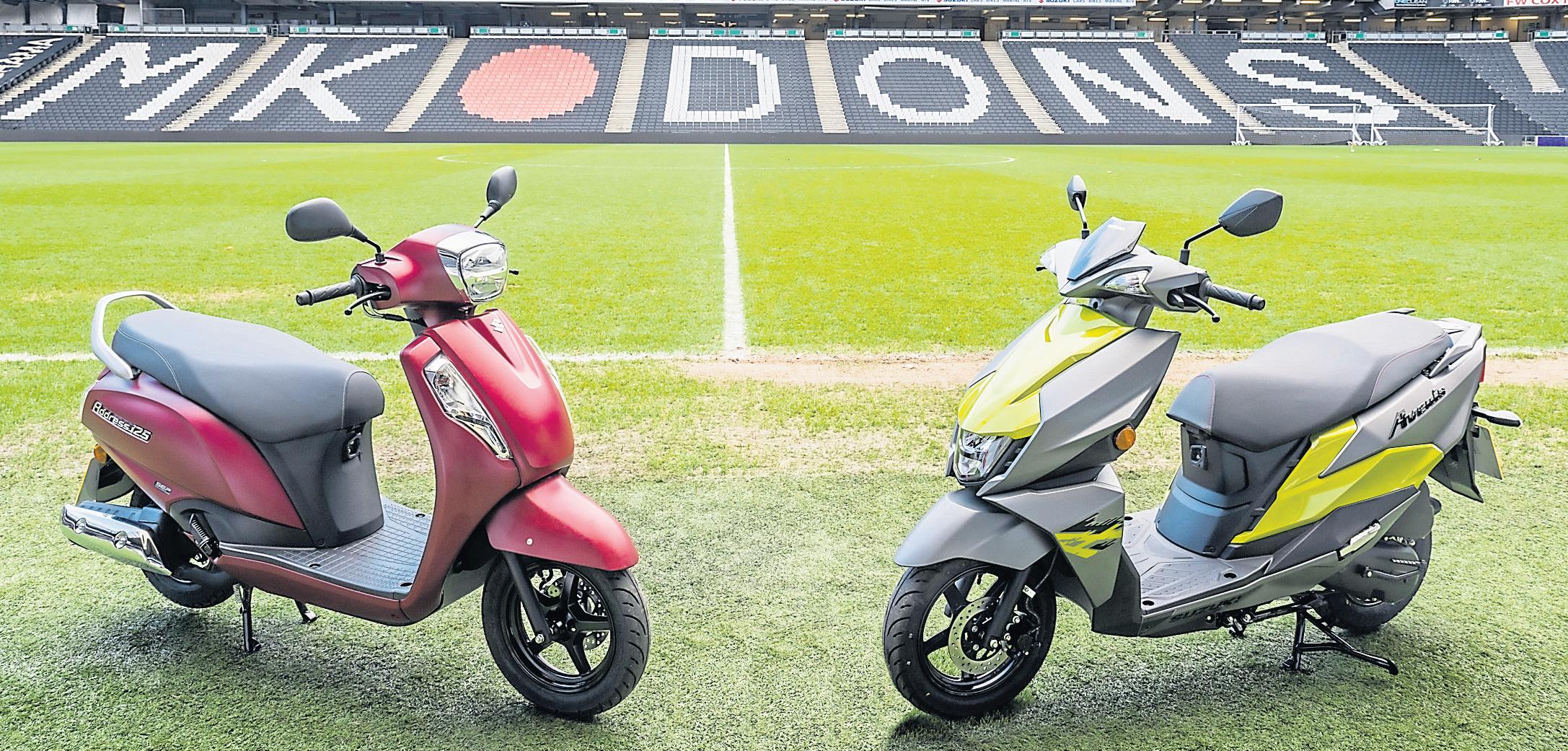



theoretical fuel range of over 160 miles. Combined with its initial high-value £2699 price tag, and what I’d expect to be minimal servicing and running costs, the scooter would give you the opportunity to seriously reduce your transport costs. If I lived in a major city, I’d give ownership some major consideration. It would make a great introduction to the world of two-wheelers for anyone new to biking, too. Being so easy to ride and manage would give you chance
to enhance your riding skills and gain some important experience before climbing the biking ladder and trying something with greater performance. The Japanese brand’s reputation for quality and reliability, together with a decent back-up, also needs to be noted. My day on the Avenis turned out to be way more enjoyable than I’d expected, and I also liked the fact it opened my mind to the world of 125cc scooters and just how much of a transport benefit they can offer.
46 LAUNCH RIDE: SUZUKI AVENIS 125 AND ADDRESS 125
WORDS and PHOTOS: Bob Pickett

Triumph shook up the middleweight naked market in 2021 when it launched the Trident.
The 660cc triple had a great engine, powerful brakes and sharp handling, yet managed to work for both new and experienced riders.
2022 saw the launch of its half-faired sibling, the Tiger Sport 660. Featuring the same engine, suspension and brakes, was it just the Trident with longer legs and a posh frock?
Give me some spec
A 660cc inline three-cylinder engine putting out 80bhp/60kW @10,250rpm with 47lb-ft/64Nm torque at 6,250rpm, is housed in a steel tubular perimeter frame.
For a bike in the middleweight class, money is spent in the right places: suspension courtesy of Showa (41mm unadjustable USD front, pre-load adjustable single rear shock) with stopping power supplied by twin 310mm, two-piston caliper Nissin up front supported by a single 255mm single disc, single piston caliper rear. Seat height is 835mm, wet weight 206kg.

Any updates from last year?
Brand new model for 2022/3.
So what is it like to ride?
The seat height was a concern: 835mm potentially too tall for my 737mm legs. Wearing my thickest soled boots, squished against the tank, feet just touched flat (leading to a comedy moment back at the dealer where I parked too close to another bike and couldn’t get off!). Bars are wide and high, pegs are low with a gentle rear-set (given the milemunching potential I’d have liked them more neutral).
The 660cc triple is unchanged from the Trident. It’s so flexible; it can roll gently under 20mph (though it would like to get a move on), but works hard when needed with buckets of torque seemingly everywhere. The first four gears are close-ratio with a stretch to the tall 5th and 6th.
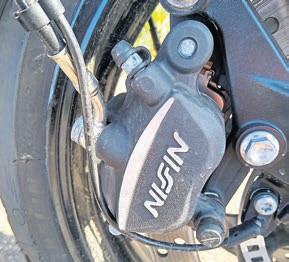

The handling is superb. Longer legs mean a slight loss in precision
but the front end fills you with confidence, gripping and holding the line no matter how hard you push. Suspension is just right; it soaked up pretty much everything but gave the right level of feedback. Brakes are powerful but with bags of feel.
With a 17-litre tank, the Tiger Sport suggests big mileage rides. The high, wide bars mean no pressure on your shoulders or wrists but the slightly tucked-in leg placement began to tell after a time. The firm but supportive seat was fine for ages but after a twohour ride I was ready to give my legs and backside a break.

The multifunction TFT screen is clear and easy to operate with toggle switches on the bars. Left/right toggles switch between modes (rain/road). I liked the gear indicator; this with the flashing rev counter (once you moved out of ‘eco’ and into ‘performance’)

was a good pairing. Niggles? The indicator and horn were in an awkward position, moved down the controls by the toggles and the mirrors could have given more feedback.
This is a great bike. Just hug the tank with your knees, relax and let the 660 Sport do it’s thing. And that’s a Very Fine Thing indeed.
How much does it cost?
£7,945 inc. VAT.
Want to try one? To test a Tiger Sport 660, contact: Triumph East London 249 London Road Romford, Essex RM7 9NB Tel: 01708 752 111 Web: https://www.lind.co.uk/ triumph/east-london
QUICK SPIN 47
Not many experiences match the exhilarating and liberating feeling of riding a motorbike. However, for all its thrills there is no denying that you are more vulnerable than other road users, which is why it is vitally important that you equip yourself with the proper protective gear before you head out on the road, to help keep yourself as safe as possible in the unfortunate scenario where you have any kind of accident.
From top to bottom, every single part of a biker’s protective gear works to keep you safe from various mishaps, whether it’s your helmet protecting your noggin from any nasty bumps; your armoured jacket and trousers keeping you safe from road rash or collisions; your gloves keeping your hands protected as well as ensuring you can keep a strong grip on the handlebars; or your boots protecting your feet (and ankles) from heat from the exhaust, any bumps or knocks, as

well as providing better grip on the pegs, brake and gear lever.
When it comes to shopping for your gear, any quick online browsing will likely make you double-take at some of the price tags you’ll see, but kitting yourself out from head to toe in great, hard-wearing equipment doesn’t have to break the bank; there are plenty of fantastic options out there for keeping yourself protected at very affordable prices.
WORDS: Chris Bailey PHOTOS: Gary Chapman
Spada Striders CE £74.99 Spada Commute Trousers CE £84.99 Spada Oslo CE £39.99
CE £94.99
Avalon
48 LEARNER LEGAL
Spada Commute
Caberg
Blast £165
HELMETS JACKETS
This is where the lion’s share of your budget will probably go.
As I mentioned last month, a motorcycle helmet is the only actual bit of protective gear you are legally required to wear. The protection they provide your head, neck and face is invaluable, whether that’s from potential accidents, road conditions or even the weather.

You should never consider buying one secondhand. A single impact is enough to weaken the affected area of the helmet, and even if no real damage is visible on the exterior, it will no longer provide proper protection. And since you can’t be 100% certain of the history of a pre-owned helmet, it is simply not worth risking your life to save a few extra quid.
When trying on helmets, you want it to feel snug but comfortable; it should be tight enough that you can shake your head from side to side without it wobbling all over the place.
Another thing to bear in mind is that since the helmet is the highest and most visible point of a rider, choosing bright colours can also help you stand out and be noticed sooner.
When it comes to picking your jacket, the main varieties you’ll see are leather and textile; personal preference aside, they each provide their own benefits.
Leather gear tends to be much more resistant to abrasions and tears, it’s durable and has a timeless style. However, they can be very heavy and on a hot day you’ll feel yourself cooking, which is a distraction you don’t want as being uncomfortable while riding takes some of your attention away from the roads. The other downside of leather is that whilst most will offer varying levels of water resistance, that waterproofing will wear away a lot sooner than with textiles. It is also worth bearing in mind that leather gear is normally much pricier than alternatives.
As for textiles, they are likely to be fully waterproof (although if you get caught in a heavy downpour you’ll likely find a small damp patch or two on any base layers). They also sometimes contain insulating layers. Textiles tend to be a lot more lightweight and breathable, at the cost of not being quite as resistant to abrasions. As well as normally being more cost-efficient, it is also easier to maintain than leather gear on a day-today basis. However, with the proper treatment and care, leathers will likely last you longer than a set of textiles.
Whichever option you choose, the most important thing of all is to ensure your jacket contains CE-approved armour. At a minimum your jacket should have protection in both shoulders and elbows, but will hopefully also include back protection, although if the latter isn’t included, you can pick up standalone back protectors to go under your jacket, which I can’t recommend enough.
TROUSERS BOOTS GLOVES
As with your jacket, you’ll be able to pick here between leather or textile options, and just like with your jacket, the main thing you will want to look for is reliable, well-designed armour, which in trousers should protect your hips and your knees at a minimum, although shin protection is great to have, too.

All the same pros and cons for leather and textile jackets are applicable to trousers… try a few different styles and see what you find most comfortable. Motorcycle jacket sizes are much more forgiving when it comes to picking your size as they tend to come in S,M,L, etc. However, with your motorcycle trousers, you’ll want to pay special attention to your leg length, not just the waist size. Leg length is so important in your trousers for a few reasons: you want your knee protection to be in the right place and you want your whole leg covered by the material, without there being so much excess that it’s baggy around the cuffs and in danger of catching on part of the bike.

Well-made gloves are so vital. In the event of a fall, pure instinct is to throw your hands out to catch yourself, so the more resistant materials normally used to create bike gloves such as leather or textiles can really protect your hands from abrasions and cuts. Most motorcycle gloves available these days also feature armour around the knuckles, which serve to help give an extra layer of protection to your hands and fingers. Bike gloves also tend to come in two thicknesses, known as summer gloves and winter gloves. Summer gloves are much thinner than winter gloves and are likely to not be waterproof and may include perforated or mesh panels to keep your hands cool during the warmer weather. Winter gloves are much thicker and are waterproof, as well as normally having some kind of insulating layer. Choose what you find most comfortable. Your hands will get cold easily whilst riding, however, with winter gloves, due to the thickness of the material, your hands feel much bulkier on the controls than with the thinner summer gloves.
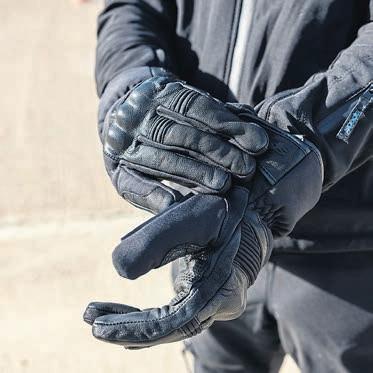
Finally, motorcycle boots. You’ll want these to have reinforced toes and heels, as well as armour on the ankles, shins and sides of your feet. This isn’t just to protect you from the road and any accidents (where regular shoes would be shredded or easily slip off), but also to keep you safe from the bike itself. Most boots are waterproof. However, not all are, so make sure to double-check before buying as the last thing you want when having to ride in the rain is to have to contend with soggy socks! The other thing you’ll need to look into first is your boot size. A lot of motorcycle boots come in European sizes which are completely different to the standard UK sizes we’re used to.

LEARNER LEGAL 49


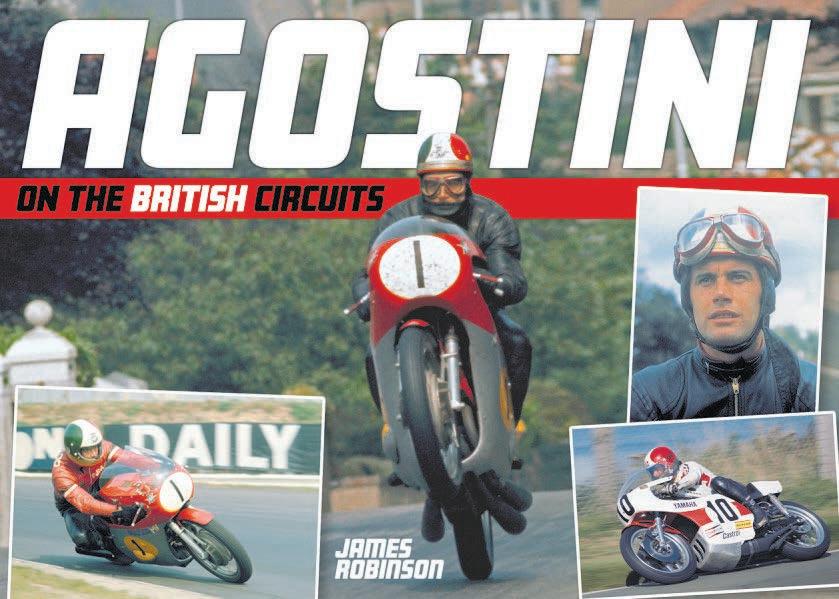




















































KING KENNY RIGHTS SOME WRONGS
A new arrival during the winter of 1977 helped Yamaha to understand where it had be going wrong that year. Kenny Leroy Roberts has been part of the American racing scene since the late 1960s and a rider for the USA Yamaha importer from 1970. Initially riding on dirt track ovals, Roberts had ridden the wheels off his XS650-based bike to worry and occasionally embarrass the then predominant factory Harleys. Moving on to road racing, the Californian had studied and modified the riding techniques of Jarno Saarinen to great effect. Good rides on the TZ750 at

Daytona clearly demonstrated his proficiency and when he raced at Imola and the UK Transatlantic Race series it was evident he knew his stuff. Not only was Roberts a skilled rider, he was also extremely adept at analysing and identifying facets of motorcycle design. This skill had come from his days of dirt track riding where it was vital for the ride to know exactly what his machine was doing underneath him if he was to trust it going into a turn. Was it squirming around because it couldn’t get grip, or were there fundamental issues with frame design or power delivery?
KR, as he became known, was one of those rare riders who could tell a race team exactly what was right or wrong about each facet of their machine.

The OW35’s failure to live up to expectations had ben caused by a fatal flaw in the bike’s design. That the Yamahas unquestionably were faster than the more successful Suzukis was evident on long straights at various GPs. Where it went all wrong was in the corners – the RG500s entered, negotiated and exited corners much more predictably that the TZ500s, but why? There were two key issues and Yamaha was going to have to face up to both.



Right at the start of its development life back in 1974 the RG500 had received input from British racer Barry Sheene, who also just happened to have a similar mindset to Kenny Roberts. Barry was able to identify problems, highlight deficiencies
and often persuade engineers and designers to change key elements. This didn’t automatically mean that the RG500 was perfect but, in general terms, it was less flawed than the Yamaha.

Few who rode the Suzuki would say it had an easy and predictable power delivery, but it was significantly less ‘off-then-on’ than the Yamaha, making it smoother to ride and less fraught when not on full power.

Overall, the RG was simply smoother around a track than the TZ.
Roberts rightly concluded that the OW35’s handling issue was largely down to an overly severe rebound damping of the rear shock and the positioning of its swing arm pivot which was too high. The combination

of the two had conspired massively to compromise the bike’s handling manners, but that wasn’t all.
The TZ’s high and wafer-thin power band had effectively made the throttle more of an on/off switch than a proportioning device. Yamaha had focussed on out-and-out power in the misguided belief it was the only way to win. A serious review of priorities was definitely required!

THE INSIDE LINE TO CLASSIC JAPANESE IRON WITH STEVE COOPER FROM THE VJMC 51
WANT YOUR FIX OF JAPANESE CLASSICS? THEN YOU NEED... Visit www.classicmagazines.co.uk/cmm296 Call: 01507 529529 and quote: CMM296 6 issues for £24* Expiry: 31/12/23* UK only offer *Followed by £24 every six months The VJMC – run by motorcyclists for motorcyclists. For membership enquiries only Tel: 01454 501310 Email: membership_vjmc@yahoo. co.uk Address: PO Box 1949, Yate, Bristol BS37 0BX Office hours: Mon-Thurs,10am4pm (please leave a message)
Words: Steve Cooper Photo: Mortons Media Archive
TELL US ABOUT YOUR RIDE!
Share your travel story, and bag a free subscription

We love to read about our readers’ rides and adventures. Whether it’s a local bimble to your favourite spot; a week spent touring and exploring; a one-off trip of a lifetime; or anything (and everything) in between, if you have a story to tell we’d love to hear it.
You don’t need to be a professional writer. We will give you a brief to follow, and edit your words before publishing. All you need is a good route, a destination, or a story to share, with plenty of quality photos to help bring the words to life.
Most of our articles are either rides that you can do in a day, somewhere between a weekend and a week, or anything above a week. Basically, if it’s a ride you enjoyed, the chances are that other motorcyclists would, too.


Sadly there are no big pay cheques for the writers, but if your story does make it to the magazine, we’ll give you a free 12-month subscription. So, gather together your photos, tap away on the keyboard, and drop us a line at rmowbray@mortons.co.uk to get the editorial wheels rolling.



We look forward to hearing your story!
Biker Friendly Guide
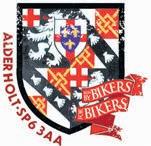



So now you want to be out and about, riding those roads, feeling your bike run beautifully and watching those bugs splat on your visor. On your own or as part of a group, it’s what we live for.
We’re sure you will have your favourite route, but if you are looking for a few ideas on where else to go, what to do, where to chat to like-minded folk and perhaps just have a great brew at a place which guarantees a warm welcome, then these are the pages for you.


You can always find some interesting roads to and from any of these great venues, and it’s also worth bearing in mind that when you get there, chances are you’ll find some fellow bikers keen to chat about your machine, your route... and share their own experiences too.
As you can see from the map, there are cafes, bars and venues all around the UK which are perfect for a visit.

So go on, support these venues which love their bikers... get out there and pay them a visit, you will not be disappointed!

1 2 4 5 6 3 3 4 5 6 1 2
52 NEWS








































































































































































































































































CLASSIFIEDS ACCESSORIES TYRES
BRAKELINES CHROMING www.morebikes.co.uk
WEBWATCH
For Sale
AJS R12 1930, rare vintage motorcycle, matching numbers, original registration and logbook, storage since 1960, very original condition, perfect to restore, very rare find, some spares, best offer secures Tel. 02088 944704. Surrey.
BMW R1200RS 2005, panniers, new pump, needs battery, mint, dry rides, low mileage, stored, £1000. Tel. 07500 119444.

BSA B31 1948, rigid frame is in original condition with no lugs missing, Triumph T140 piston and belt driven clutch conversion, new tyres, Goldie forks, £5000 ovno Tel. 07513 168824. Notts.
DUCATI 996 2000, not used for six years, kept indoors, would benefit service and change cam belts, £6700 text via Whats-app forpicturesandmoreinformation Tel. 07742 806790. North Wiltshire.
HARLEY-DAVIDSON Dyna FXDC, 1584cc, 2013, black, 6730 miles, extras Vance & Hines exhaust, touring pack, panniers, Sundowner dual seat, detachable windscreen, ‘D’ bars, £9500. Tel. John 07717 768687. Cornwall.
HONDA VFR1200FD 2014, metallic red, 29,000 miles, £4999. Honda CB750/4 KZ, 1979, black, 09k, £4999. Norton CB500 Interstate, black, 31,000 miles, £4999. Buffalo R/Suit, 5’10” high; 44” waist, black, new, £149. Leather motorcycle jacket 44”/46” waist, black, used, £49. Alpenstar L/boots, size 10, black, used, £49 Tel. 07759 607498. East Berks.
SUZUKI Tempter 400, 1999, owned 10 years, excellent condition, needs nothing, 4LS front brake, flanged rims, light weight and low seat height, sensible offers considered, reducing collection, £3750 Tel. 07799 220450.
TRIUMPH Bonneville classic bike, 1966, done 2731 miles since refurbished in 2011 by Gatfield Classics, very good condition used regularly, best in show at Amlwch Classic Car and Bike show 2018, 11 months MoT, matching numbers, £8000 ono Tel. 01407 830194. Anglesey.
BSA A10 big journal crank, £120.Sumpplate,£10.Gearbox, £180. Small Journal crank rods, £110. Small journal con rods, £30. Front wheel, £120. Dunlop rim, £15. Rocket crank cases, £125 Tel. 07968 390904.
DUNLOP K82 TYRE 300 x 18” never fitted or used bought in error (wrong rim size) needed 19”, cost £69 open to sensible offer please Tel. Alan 01268 735135. Essex.
HENDLER HANDLEBARS
new, £30. Harley discs pair
Wanted
ARIEL HUNTMASTER (FH) all black,12,800provenmilessince engine and gearbox rebuild, 12 volt lighting, with indicators, dynamo belt drive, dynamo regulators solid state electronic regulator, recent new battery, good Avon Roadrider tyres, twin leading shoe front brake, alloy sump plate with magnetic sump bolt, lovely bike in immaculate condition, regularly used, £6200
Tel. Tony 02476 598700; 07968 390994. Midlands.
GREEVES Sports Twin Roadster, 250cc, V5C, Moorland blue, alloy mudguards, paddle hubs, new tyres, correct seat, good tidy useable British lightweight excellent condition, £3995 Tel. 01268 735135. Essex.
HONDA VFR750 FM J-reg, 25,000 miles approx, needs recommissioning as stood for few years, cash on collection, based in N/E Somerset, £975 Tel. 07474 128407.

KAWASAKI ZX6R 2000, X reg, one lady owner for the last 14 years, good tyres, chain and sprockets, very clean and well loved bike, 50,800 miles, full front calipers clean and new seals at 49,000, hugger and R&G crash protectors, £1450 ovno Tel. 07795 680499.
HONDA CB400F2 1977, new tyres,newelectrics,reconditioned carbs, alloy rims S/S spokes, spares good condition, 35,000 miles, Tel. Keith 07391 901041. Email. keith.palmer@tiscali.co.uk East Yorks.
BSA 650 red and chrome petrol tank and black frame, 8300 proven miles since full engine rebuild, Triumph 4 spring clutch and oil filter fitted, 12 volt lighting, dynamo belt drive, dynamo regulators solid state electronic regulator, good Avon Road Rider tyres, twin leading shoe front brake, alloy sump plate with magnetic sump bolt, lovely lookingbikeregularlyused in excellent condition, £4500
Tel. Tony 02476 598700; 07968 390994. Midlands.
HONDA CG125 BR-J, 1989, runs very well, 10 months MoT, remarkable condition, new forks and seals, new seat cover, 2 x original keys and log book, £1200 ono Text. 07969 605089. Surrey.
HONDA ZOOMER Ruckus
NPS50, nice and very original little 2007, MoT to Feb 2024, recent new Michelin Bopper tyres, approximately 16,000 miles (speedo was changed last year so currently reads 14,000 miles), alarm, charging socket and under seat storage, £1950 Tel. 07734 004323.
HONDA SHADOW 1998, MoT, 600cc, very good condition, 10,250 miles, custom black, orange, £2800 possible p/x Tel. 07395 910839. Norfolk.

KAWASAKI KLX300 2002, road reg, road tyres, FMF exhaust, very good condition, modified seat renthals, lovely bike to ride, very reliable, £3000 ono Tel. 01225 743415.
KYMCO X-CITING 2021, 6900 miles, summer use only, 400cc, 36 BHP model in blue, new scooter forces sale, 71 reg, ace comfy maxi scooter, fsh, adjustable screen, sat-nat, 84 mpg,£3699.Tel.07784499299.
NORTON INTERSTATE 1972 Special, fitted CB500 black toolkit twin, £5250. Honda 750/4, 1979 L/M 9k, new pipes x 4 tyres, battery, black, £5500. New: books V. Rossi & Moto GP, £8/£12. New: L/rg suit 5’10” XL B/W/R,£150Tel.07759607498. East Berkshire.
SUZUKI GT500A 1976, 27,000 miles, UK bike, good runner, good condition, restored in 1990, gearbox rebuilt, one re-bore 0.5mm, silencers re-chromed, frame stove-enamelled, seat, horn, brake lever, wheels not original, Haynes manual included, £4750 Tel. 07977 556640. Email. helenhunt3@ btinternet.com


SUZUKI RF900R 1996, good condition,goodtyres,box,recent new chain, needs water pump, current MoT, offers Tel. 07968 315098. Wiltshire.
TRIUMPH Bonneville, 2005, black and chrome, full MoT, good condition, £3500 ono Tel. Tom 01697 331834. Cumbria.
TRIUMPH T120R Bonneville, 1970, 650cc, matching frame and engine numbers, excellent condition, runs well, no smoke or rattles, photos by phone, becoming quite rare, £7295. Tel. 07887 674467. Hants.
YAMAHA FJR1300 2003, red, 9550 miles, excellent condition, MoT June 2023, full touring pack, tank graphics, collectors bike,£4500.Tel.07717768687.
YAMAHA Dragstar XVS125, V-Twin 125 cruiser in good condition with new tyres and tubes and MoT to end Sept 2023, runs and rides well, big bike custom looks for a 125! Can be ridden with CBT or A1 licence, £2495 Tel. 07910 285178.
PFM HD002-4807, rear Zodiac 235473 HDF Front, £70 pair. Suzuki GSF600 Bandit ‘new’ foot pegs, £12. New clutch switch, £2.50. Bandit new rear brake pads, £8. Gear lever, £20 Tel. 07704 343331.
SUZUKI SV650 radiator cover, new boxed, £20. Rear SV650 suspension spring as new, £50. SV650 fork internals as new, £20. Tel. 07974 024893. North Yorks.
TRIUMPH SPRINT and Tiger 900 parts: 1995, cylinder heads with camshafts and rubber rocket gasket, head covers, pistons, conrods starter clutch, valves, shims, camchain guide, valve springs etc, £200. Tel. 07448 927393.
TRIUMPH THUNDERBIRD 900
ANY
CLASSIC MOTORCYCLE wanted by enthusiast anything considered in any condition, rusty tatty nice etc, good price paid can collect Tel. Tom 01514 470147. Cheshire.

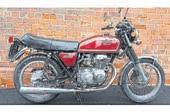

CLASSIC BIKE WANTED anything considered in any condition by enthusiast top price paid call Tel. 01514 470147.



Miscellaneous
BELSTAFF LEATHER JACKET black vintage with removeable fur lining, large, £400, todays new price £1350. TT leathers International wax cotton trials trousers, med/large as new, £40 Tel. 01484 663007. West Yorks.
FOR SALE MINI V5 VAN shell, £3500 will take classic bike, cash difference Tel. 07799 754761. Lancashire.
LAMBRETTA 150 MK2
Instruction Booklet, as new, £10. Lambretta scooter Maintenance/Repair book, all models from 1952 as new, £10.
The Official Lambretta Workshop Manual, printed by Lambretta Concessionaires Tel. 01484 663007. West Yorkshire.
YAMAHA XT225 1992, needs somework,£900onoTel.07484 103498. Somerset.


Parts For Sale
AFTERMARKET SEAT to suit Honda CX500, excellent condition, no damage whatsoever, like new, £40 ono Tel. 07717 742550. ARIEL ARROW 60-62 job lot, engine parts, £80 the lot Tel. Phil 01214 757249.
new old stock, chrome sprocket cover original box, mint fits Adventurer Legend Sport, £400 + £7 postage. Also black plastic OE clocks covers, £70 + £5 postage. Rear brake, £35 + £5 postage Tel. 07434 513161. Lancashire.
YAMAHA MT09 TRACER 2015 power bronze touring screen, tallerandwiderthanthestandard unit, will fit models up to 2017, very good condition, collection in Tadcaster, North Yorkshire, can post if required, £35 Tel. 07496 566163. North Yorks
RACING LEATHERS by MW London, medium, £45. RM wax cotton trials jacket style, medium, new, £80. Yamaha Workshop Manuals 250-400 DT Trail 1968-79, 1971 onwards, rare as new, £15 each Tel. 01484 663007. West Yorkshire.
SEALEY MOTORCYCLE heavy duty front wheel chock FPS7.V2, £25. Motorcycle ramp l/weight folding aluminium max weight, 200kg, £25 both excellent condition Tel. 07849 685043. Lincolnshire.
WATSONIANSQUIRE motorcycle trailer, blue fibre glass, new tyres, new inner tubes, new lights, can send pictures, £400. ono Tel. 07704 343331.
Selling your bike is FREE for private readers Choose one of the following methods: 1 ONLINE www.morebikes.co.uk 2 EMAIL freeads@morebikes.co.uk 3 POST MB Reader Adverts, Media Centre, Morton Way, Horncastle, Lincs LN9 6JR Classified




















































































































































































































































































 WORDS: Dave Manning, Gary Hartshorne, Ross Mowbray PHOTOS: Gary Chapman
WORDS: Dave Manning, Gary Hartshorne, Ross Mowbray PHOTOS: Gary Chapman








 The supercharged inline four motor is special. It’s like nothing else on the market and is the best bit about the bike
The supercharged inline four motor is special. It’s like nothing else on the market and is the best bit about the bike






 Twin engines always sound good, right?
The dash has been lifted from the Africa Twin and features the TFT/LCD combo. The screen worked best in its high position
Twin engines always sound good, right?
The dash has been lifted from the Africa Twin and features the TFT/LCD combo. The screen worked best in its high position






















































































































































































































 Danny McFadden
Danny McFadden










































































































































































































































































